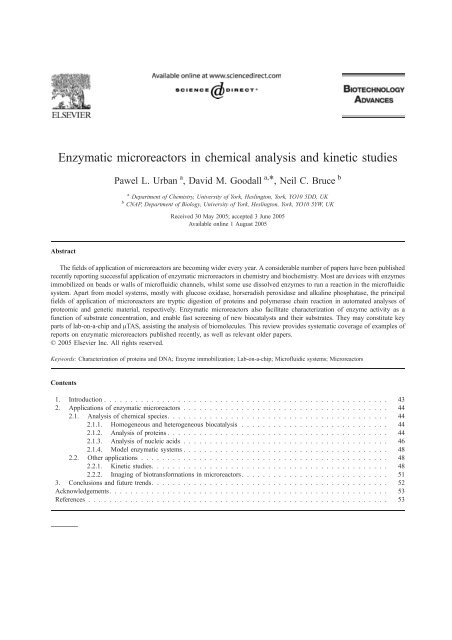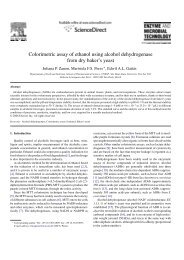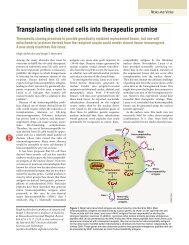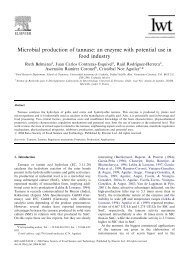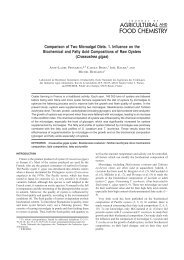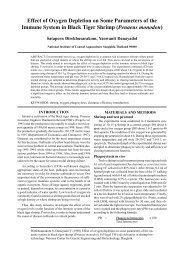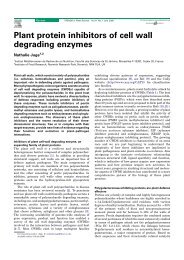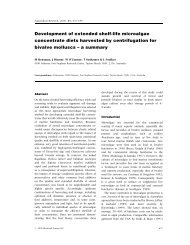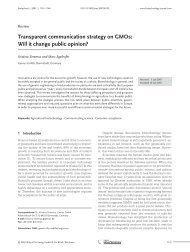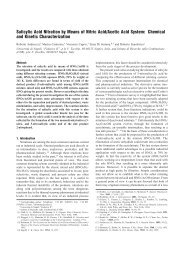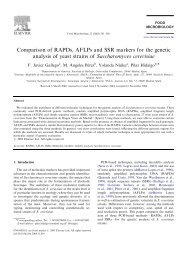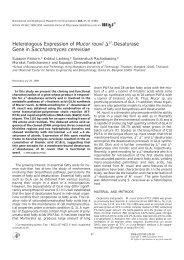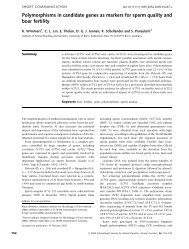Enzymatic microreactors in chemical analysis and kinetic studies
Enzymatic microreactors in chemical analysis and kinetic studies
Enzymatic microreactors in chemical analysis and kinetic studies
Create successful ePaper yourself
Turn your PDF publications into a flip-book with our unique Google optimized e-Paper software.
<strong>Enzymatic</strong> <strong>microreactors</strong> <strong>in</strong> <strong>chemical</strong> <strong>analysis</strong> <strong>and</strong> k<strong>in</strong>etic <strong>studies</strong><br />
Abstract<br />
Pawel L. Urban a , David M. Goodall a, *, Neil C. Bruce b<br />
a Department of Chemistry, University of York, Hesl<strong>in</strong>gton, York, YO10 5DD, UK<br />
b CNAP, Department of Biology, University of York, Hesl<strong>in</strong>gton, York, YO10 5YW, UK<br />
Received 30 May 2005; accepted 3 June 2005<br />
Available onl<strong>in</strong>e 1 August 2005<br />
The fields of application of <strong>microreactors</strong> are becom<strong>in</strong>g wider every year. A considerable number of papers have been published<br />
recently report<strong>in</strong>g successful application of enzymatic <strong>microreactors</strong> <strong>in</strong> chemistry <strong>and</strong> biochemistry. Most are devices with enzymes<br />
immobilized on beads or walls of microfluidic channels, whilst some use dissolved enzymes to run a reaction <strong>in</strong> the microfluidic<br />
system. Apart from model systems, mostly with glucose oxidase, horseradish peroxidase <strong>and</strong> alkal<strong>in</strong>e phosphatase, the pr<strong>in</strong>cipal<br />
fields of application of <strong>microreactors</strong> are tryptic digestion of prote<strong>in</strong>s <strong>and</strong> polymerase cha<strong>in</strong> reaction <strong>in</strong> automated analyses of<br />
proteomic <strong>and</strong> genetic material, respectively. <strong>Enzymatic</strong> <strong>microreactors</strong> also facilitate characterization of enzyme activity as a<br />
function of substrate concentration, <strong>and</strong> enable fast screen<strong>in</strong>g of new biocatalysts <strong>and</strong> their substrates. They may constitute key<br />
parts of lab-on-a-chip <strong>and</strong> ATAS, assist<strong>in</strong>g the <strong>analysis</strong> of biomolecules. This review provides systematic coverage of examples of<br />
reports on enzymatic <strong>microreactors</strong> published recently, as well as relevant older papers.<br />
D 2005 Elsevier Inc. All rights reserved.<br />
Keywords: Characterization of prote<strong>in</strong>s <strong>and</strong> DNA; Enzyme immobilization; Lab-on-a-chip; Microfluidic systems; Microreactors<br />
Contents<br />
1. Introduction . . . . . . . . . . . . . . . . . . . . . . . . . . . . . . . . . . . . . . . . . . . . . . . . . . . . . . 43<br />
2. Applications of enzymatic <strong>microreactors</strong> . . . . . . . . . . . . . . . . . . . . . . . . . . . . . . . . . . . . . . . 44<br />
2.1. Analysis of <strong>chemical</strong> species. . . . . . . . . . . . . . . . . . . . . . . . . . . . . . . . . . . . . . . . . . 44<br />
2.1.1. Homogeneous <strong>and</strong> heterogeneous biocatalysis . . . . . . . . . . . . . . . . . . . . . . . . . . . . 44<br />
2.1.2. Analysis of prote<strong>in</strong>s . . . . . . . . . . . . . . . . . . . . . . . . . . . . . . . . . . . . . . . . . . 44<br />
2.1.3. Analysis of nucleic acids . . . . . . . . . . . . . . . . . . . . . . . . . . . . . . . . . . . . . . . 46<br />
2.1.4. Model enzymatic systems . . . . . . . . . . . . . . . . . . . . . . . . . . . . . . . . . . . . . . . 48<br />
2.2. Other applications . . . . . . . . . . . . . . . . . . . . . . . . . . . . . . . . . . . . . . . . . . . . . . . 48<br />
2.2.1. K<strong>in</strong>etic <strong>studies</strong>. . . . . . . . . . . . . . . . . . . . . . . . . . . . . . . . . . . . . . . . . . . . . 48<br />
2.2.2. Imag<strong>in</strong>g of biotransformations <strong>in</strong> <strong>microreactors</strong> . . . . . . . . . . . . . . . . . . . . . . . . . . . . 51<br />
3. Conclusions <strong>and</strong> future trends. . . . . . . . . . . . . . . . . . . . . . . . . . . . . . . . . . . . . . . . . . . . . 52<br />
Acknowledgements. . . . . . . . . . . . . . . . . . . . . . . . . . . . . . . . . . . . . . . . . . . . . . . . . . . . . 53<br />
References . . . . . . . . . . . . . . . . . . . . . . . . . . . . . . . . . . . . . . . . . . . . . . . . . . . . . . . . . 53
1. Introduction<br />
Microreactors are usually def<strong>in</strong>ed as m<strong>in</strong>iaturized<br />
reaction systems fabricated by us<strong>in</strong>g, at least partially,<br />
methods of microtechnology <strong>and</strong> precision eng<strong>in</strong>eer<strong>in</strong>g<br />
(Ehrfeld et al., 2000). The term bmicroreactorQ is the<br />
proposed name for a wide range of devices hav<strong>in</strong>g<br />
small dimensions, <strong>and</strong> a further division accord<strong>in</strong>g to<br />
size <strong>in</strong>to nano, micro <strong>and</strong> m<strong>in</strong>ireactors is hardly ever<br />
used (Ehrfeld et al., 2000). Most of the currently constructed<br />
microreaction devices take advantage of microfluidics<br />
<strong>and</strong> nanofluidics, which enables use of micro<br />
<strong>and</strong> nanolitre volumes of reactive species <strong>and</strong> ensures<br />
high efficiency as well as repeatability of biocatalytic<br />
processes. Microreactors f<strong>in</strong>d applications <strong>in</strong> organic<br />
synthesis (Haswell <strong>and</strong> Watts, 2003; Hessel et al.,<br />
2004). An example of an application <strong>in</strong> biotechnology<br />
is the fast multi-step synthesis of peptides (Watts et al.,<br />
2001). The ma<strong>in</strong> benefits of application of <strong>microreactors</strong><br />
<strong>in</strong> <strong>in</strong>dustry are: faster transfer of results of development<br />
work <strong>in</strong>to production, earlier start of production<br />
at lower costs, easier scale-up of production capacity,<br />
smaller plant size, lower costs for transportation, materials<br />
<strong>and</strong> energy, <strong>and</strong> more flexible response to market<br />
dem<strong>and</strong>s (Ehrfeld et al., 2000).<br />
Though the majority of papers describe <strong>microreactors</strong><br />
as components of microfluidic devices, this term is<br />
also used <strong>in</strong> context of self-organised systems such as<br />
reverse micelles (Madamwar et al., 1988; Chop<strong>in</strong>eau et<br />
al., 1998; Carvalho <strong>and</strong> Cabral, 2000), liposomes (Oberholzer<br />
et al., 1999; Walde <strong>and</strong> Ichikawa, 2001) <strong>and</strong><br />
microemulsions (Garti et al., 1997; Garti, 2003). Selforganised<br />
systems will not be discussed <strong>in</strong> this review.<br />
Analytical systems which comprise <strong>microreactors</strong> are<br />
expected to be characterized by outst<strong>and</strong><strong>in</strong>g repeatability<br />
<strong>and</strong> reproducibility, due to replac<strong>in</strong>g batch iterative steps<br />
<strong>and</strong> discrete sample treatment by flow <strong>in</strong>jection systems.<br />
The possibility of perform<strong>in</strong>g similar analyses <strong>in</strong> parallel<br />
is an attractive feature for screen<strong>in</strong>g <strong>and</strong> rout<strong>in</strong>e use.<br />
Microreactors have been <strong>in</strong>tegrated <strong>in</strong>to automated analytical<br />
systems (Pfohl et al., 2003), <strong>and</strong> as well as provid<strong>in</strong>g<br />
benefits from system automation this also<br />
elim<strong>in</strong>ates errors associated with manual protocols. Further<br />
advantages of the use of <strong>microreactors</strong> <strong>in</strong> analytical<br />
chemistry are that they can be coupled with numerous<br />
detection techniques (Schwarz <strong>and</strong> Hauser, 2001; Verpoorte,<br />
2003a,b), <strong>and</strong> that pretreatment of the samples<br />
can be carried out on the chip (de Mello <strong>and</strong> Beard, 2003;<br />
Chiesl et al., 2005). Methods of <strong>in</strong>jection of the fluids<br />
<strong>in</strong>to microchannels, <strong>and</strong> connect<strong>in</strong>g <strong>and</strong> <strong>in</strong>terfac<strong>in</strong>g<br />
<strong>microreactors</strong> with other system components, are also<br />
be<strong>in</strong>g improved. This should help elim<strong>in</strong>ate any rema<strong>in</strong>-<br />
<strong>in</strong>g obstacles to more widespread uptake of the technology<br />
(Fang, 2004). M<strong>in</strong>iaturized analytical assays are<br />
useful <strong>in</strong> many branches of biotechnology (Guijt-van<br />
Duijn et al., 2003). The <strong>in</strong>fluence of nanotechnology <strong>in</strong><br />
the development of biosensors has been reviewed by<br />
Jianrong et al. (2004). Whilst recently published books<br />
cover <strong>in</strong>dustrial applications of <strong>microreactors</strong> (Ehrfeld et<br />
al., 2000; Hessel et al., 2004, 2005a,b), analytical applications<br />
are of <strong>in</strong>creas<strong>in</strong>g importance <strong>and</strong> are therefore<br />
also surveyed <strong>in</strong> the present review.<br />
<strong>Enzymatic</strong> <strong>microreactors</strong> have been developed <strong>in</strong><br />
order to facilitate rout<strong>in</strong>e work <strong>in</strong> bio<strong>chemical</strong> <strong>analysis</strong>,<br />
<strong>and</strong> also have applications <strong>in</strong> biocatalysis. A low expenditure<br />
of the enzyme is often a result of its immobilization.<br />
However, the range of immobilized enzymes<br />
available with satisfactory characteristics is still limited<br />
(Buchholz et al., 2005), which <strong>in</strong>evitably decreases the<br />
number of potential applications. The follow<strong>in</strong>g immobilized<br />
enzymes are used on an <strong>in</strong>dustrial scale: glucose<br />
isomerase, sucrose mutase, h-galactosidase, penicill<strong>in</strong><br />
acylase, d-am<strong>in</strong>o acid oxidase, glutaryl amidase, thermolys<strong>in</strong>,<br />
nitrilase, am<strong>in</strong>oacylase <strong>and</strong> hydanto<strong>in</strong>ases<br />
(Buchholz et al., 2005).<br />
<strong>Enzymatic</strong> <strong>microreactors</strong> have been used for analytical<br />
applications as components of <strong>in</strong>tegrated systems,<br />
often termed lab-on-a-chip or <strong>in</strong> micro total <strong>analysis</strong><br />
systems (ATAS) (Vilkner et al., 2004). Although the<br />
first enzymatic <strong>microreactors</strong> were constructed <strong>in</strong> the<br />
1970s <strong>and</strong> 1980s, the growth <strong>in</strong> their practical applications<br />
dates to the late 1990s. No examples of enzymatic<br />
<strong>microreactors</strong> were <strong>in</strong>cluded <strong>in</strong> the first comprehensive<br />
book on <strong>microreactors</strong> published <strong>in</strong> 2000 (Ehrfeld et al.,<br />
2000).<br />
It is helpful to divide the analytical applications of<br />
enzymatic <strong>microreactors</strong> <strong>in</strong>to two classes. Firstly,<br />
those which use biocatalysis <strong>in</strong> order to transform<br />
an analyte difficult to measure <strong>in</strong>to an easily measurable<br />
form. Secondly, <strong>microreactors</strong> designed for<br />
screen<strong>in</strong>g of substrates, enzymes <strong>and</strong> exam<strong>in</strong>e their<br />
k<strong>in</strong>etic characteristics. The first category is exemplified<br />
by the large number of microsystems designed<br />
for digestion of prote<strong>in</strong>s to convert them to morereadily<br />
measured peptides. Another example is oxidation<br />
of glucose by glucose oxidase followed by<br />
measur<strong>in</strong>g chemilum<strong>in</strong>escence of lum<strong>in</strong>ol oxidised<br />
by hydrogen peroxide formed <strong>in</strong> the primary reaction<br />
(L’Hostis et al., 2000). The second category is exemplified<br />
by work presented by Seong et al. (2003) to<br />
quantitatively measure enzyme k<strong>in</strong>etics <strong>in</strong> a cont<strong>in</strong>uous-flow<br />
microfluidic system.<br />
The aim of this review is to summarize recent<br />
work <strong>in</strong> the field of enzymatic <strong>microreactors</strong>, which
constitutes a new branch of microtechnology. Objectives<br />
are to highlight new aris<strong>in</strong>g trends <strong>in</strong> the<br />
development of enzymatic <strong>microreactors</strong>, to show<br />
their present applications <strong>in</strong> applied analytical chemistry<br />
<strong>and</strong> bio<strong>chemical</strong> <strong>studies</strong>, <strong>and</strong> to consider possible<br />
implications of enzymatic <strong>microreactors</strong> <strong>in</strong><br />
biotechnology.<br />
2. Applications of enzymatic <strong>microreactors</strong><br />
The achievements <strong>in</strong> <strong>chemical</strong> <strong>and</strong> bio<strong>chemical</strong><br />
microreaction systems before 2000 have been highlighted<br />
by Haswell <strong>and</strong> Skelton (2000). Developments<br />
<strong>in</strong> immobilized microfluidic enzymatic reactors have<br />
been discussed by Krenková <strong>and</strong> Foret (2004). Girelli<br />
<strong>and</strong> Mattei (2005) have recently reviewed the applications<br />
of immobilized enzyme reactors <strong>in</strong> high performance<br />
liquid chromatography: most of the constructed<br />
reactors used enzymes bound covalently to the support,<br />
<strong>and</strong> the functional groups <strong>in</strong>volved <strong>in</strong> the b<strong>in</strong>d<strong>in</strong>g were<br />
am<strong>in</strong>o, epoxyl, carboxyl, diol <strong>and</strong> phenolic. Examples<br />
were given of enzyme-catalysed reactions carried out<br />
before or after the column separation, as well as <strong>in</strong> the<br />
column.<br />
2.1. Analysis of <strong>chemical</strong> species<br />
This section commences with coverage of the types<br />
of <strong>microreactors</strong> used, with the classification <strong>in</strong>to homogeneous<br />
<strong>and</strong> heterogeneous biocatalysis. All of the<br />
examples of successful application of enzymatic <strong>microreactors</strong><br />
with immobilized enzymes presented <strong>in</strong> this<br />
review can be classified <strong>in</strong>to the follow<strong>in</strong>g groups: (i)<br />
<strong>analysis</strong> of prote<strong>in</strong>s, (ii) <strong>analysis</strong> of nucleic acids, <strong>and</strong><br />
(iii) model enzymatic systems. Separate subsections<br />
describe each <strong>in</strong> turn.<br />
2.1.1. Homogeneous <strong>and</strong> heterogeneous biocatalysis<br />
Microreactors may use an immobilized enzyme, or<br />
its solution may be <strong>in</strong>jected to the reaction zone; the<br />
two approaches encompass heterogeneous <strong>and</strong> homogenous<br />
biocatalysis, respectively. The majority of published<br />
applications refer to use of immobilised<br />
enzymes. An example of homogeneous biocatalysis<br />
on a microscale is electrophoretically mediated micro<strong>analysis</strong><br />
(EMMA), first described by Bao <strong>and</strong> Regnier<br />
(1992) <strong>and</strong> later referred to as EMMA (Regnier et al.,<br />
1995), which makes use of different mobility of an<br />
enzyme <strong>and</strong> its substrate <strong>in</strong> order to mix the zones of<br />
both <strong>and</strong> to accomplish bioconversion of the substrate<br />
to the product. The enzyme solution is <strong>in</strong>jected <strong>in</strong>to a<br />
fused silica capillary followed by <strong>in</strong>jection of its sub-<br />
strate, <strong>and</strong> the capillary is considered as the microreactor<br />
(Avila <strong>and</strong> Whitesides, 1993; Van Dyck et al.,<br />
2003). In spite of the apparent complexity, such a<br />
configuration is suitable for automation <strong>and</strong> control of<br />
the time of contact between the catalyst <strong>and</strong> its substrate.<br />
However, the EMMA method is only feasible <strong>in</strong><br />
the case of fast catalytic processes, s<strong>in</strong>ce contact times<br />
are typically <strong>in</strong> the range milliseconds to seconds.<br />
EMMA is advantageous because the amounts of enzyme<br />
<strong>and</strong> substrate used are extremely small (Kanie<br />
<strong>and</strong> Kanie, 2003).<br />
Apart from enzymes, another <strong>chemical</strong> species (e.g.<br />
an antibody) may be immobilized <strong>in</strong> the microchannel<br />
<strong>and</strong> an enzyme <strong>in</strong>volved <strong>in</strong> the specific reaction may be<br />
<strong>in</strong>jected to the system (Yakovleva et al., 2002). Further<br />
examples of microsystems without immobilized<br />
enzymes <strong>in</strong>volve conversions catalyzed by alkal<strong>in</strong>e<br />
phosphatase (Liu et al., 2004; Moorthy et al., 2004),<br />
glucose oxidase, catalase, urease (Zhang <strong>and</strong> Tadigadapa,<br />
2004), glycosidase (Kanno et al., 2002) <strong>and</strong> laccase<br />
(Maruyama et al., 2003), illustrat<strong>in</strong>g a wide range<br />
of enzymes that can be applied <strong>in</strong> such microsystems.<br />
The mode of operation <strong>in</strong>volv<strong>in</strong>g homogeneous catalysis<br />
is relatively easy to achieve, s<strong>in</strong>ce there is no need<br />
for immobilization of the enzyme. A drawback of us<strong>in</strong>g<br />
homogeneous biocatalysis <strong>and</strong> <strong>in</strong>ject<strong>in</strong>g the enzyme<br />
solution to the microreactor is the difficulty of enzyme<br />
recycl<strong>in</strong>g, as well as the necessity of its cont<strong>in</strong>uous<br />
dosage. Nevertheless, the use of microfluidic components<br />
allows the reactions to be achieved <strong>in</strong> nanolitre<br />
volumes without excessive expenditure of biocatalytic<br />
species.<br />
Use of <strong>microreactors</strong> with enzymes immobilized<br />
either on packed beads or on the <strong>in</strong>ner wall of the<br />
channel does not require cont<strong>in</strong>uous supply of the<br />
biocatalyst with<strong>in</strong> the run. The substrates are normally<br />
moved through the channel by application of pressure.<br />
An alternative is by use of electroosmotic flow (Haswell<br />
<strong>and</strong> Skelton, 2000), which is potentially attractive<br />
with microchannels packed with small particles which<br />
would provide high backpressure. More <strong>in</strong>formation on<br />
the solid supports used <strong>in</strong> <strong>microreactors</strong> can be found <strong>in</strong><br />
the review by Peterson (2005).<br />
2.1.2. Analysis of prote<strong>in</strong>s<br />
The greatest number of recent applications of enzymatic<br />
<strong>microreactors</strong> refer to prote<strong>in</strong> <strong>and</strong> peptide mapp<strong>in</strong>g<br />
(Table 1), an essential process <strong>in</strong> the identification<br />
<strong>and</strong> sequenc<strong>in</strong>g of prote<strong>in</strong>s. The most frequently used<br />
enzyme is tryps<strong>in</strong>, the enzyme catalyz<strong>in</strong>g the process of<br />
prote<strong>in</strong> digestion through hydrolysis of peptide bonds at<br />
a basic residue.
Table 1<br />
Application of enzymatic <strong>microreactors</strong> <strong>in</strong> the <strong>analysis</strong> of prote<strong>in</strong>s<br />
Enzyme Medium Application Reference<br />
Chymotryps<strong>in</strong> Silicon Prote<strong>in</strong> identification Ekström et al., 2000<br />
Chymotryps<strong>in</strong>,<br />
tryps<strong>in</strong>, papa<strong>in</strong><br />
Peps<strong>in</strong> Gel on a photopolymerized<br />
porous silica monolith<br />
Magnetic microparticles Specific fragmentation<br />
of high molecular-mass<br />
<strong>and</strong> heterogeneous<br />
glycoprote<strong>in</strong>s<br />
One example of such a system <strong>in</strong>volves a homemade<br />
microreactor with tryps<strong>in</strong> immobilized on controlled<br />
pore glass (CPG) beads (Bonneil et al., 2000),<br />
Prote<strong>in</strong> digestion,<br />
peptide separation,<br />
<strong>and</strong> prote<strong>in</strong> identification<br />
Peptide mapp<strong>in</strong>g <strong>analysis</strong><br />
of prote<strong>in</strong>s<br />
Korecka et al., 2004<br />
Kato et al., 2004<br />
Protease Fused-silica capillary (metal–ion<br />
chelated adsorption )<br />
Guo et al., 2003<br />
Protease Porous wall of a capillary Prote<strong>in</strong> mapp<strong>in</strong>g Guo et al., 2002<br />
Tryps<strong>in</strong> Controlled pore glass On-l<strong>in</strong>e prote<strong>in</strong> digestion,<br />
preconcentration, separation<br />
<strong>and</strong> detection (<strong>in</strong> UV)<br />
Bonneil <strong>and</strong> Waldron, 2000<br />
Tryps<strong>in</strong> Controlled pore glass Peptide mapp<strong>in</strong>g Bonneil et al., 2000<br />
Tryps<strong>in</strong> Fused-silica capillary Analysis of prote<strong>in</strong>s<br />
<strong>and</strong> peptides<br />
Licklider et al., 1995<br />
Tryps<strong>in</strong> Fused-silica capillary Digestion of prote<strong>in</strong>s Licklider <strong>and</strong> Kuhr, 1998<br />
Tryps<strong>in</strong> Fused-silica capillary On-column digestions<br />
of small amounts of prote<strong>in</strong>s<br />
Amankwa <strong>and</strong> Kuhr, 1992<br />
Tryps<strong>in</strong> Gel beads Digestion of prote<strong>in</strong>s J<strong>in</strong> et al., 2003<br />
Tryps<strong>in</strong> Glycidyl methacrylatemodified<br />
cellulose membrane<br />
Peptide mapp<strong>in</strong>g Jiang et al., 2000c<br />
Tryps<strong>in</strong> Glycidyl methacrylatemodified<br />
cellulose membrane<br />
Peptide mapp<strong>in</strong>g Jiang et al., 2000b<br />
Tryps<strong>in</strong> Glycidyl methacrylate-<br />
On-l<strong>in</strong>e frontal <strong>analysis</strong><br />
Jiang et al., 2000a<br />
modified cellulose<br />
of enzymatic products<br />
Tryps<strong>in</strong> Injected Digestion of <strong>in</strong>sul<strong>in</strong> Gottschlich et al., 2000<br />
Tryps<strong>in</strong> Micropatterned sol–gel<br />
structures <strong>in</strong> polydimethylsiloxane<br />
microchannels<br />
Prote<strong>in</strong> pattern<strong>in</strong>g Kim et al., 2001<br />
Tryps<strong>in</strong> Monolith Enzyme digestion for<br />
peptide mapp<strong>in</strong>g<br />
Peterson et al., 2003<br />
Tryps<strong>in</strong> Monolith Analysis of prote<strong>in</strong>s Xie et al., 1999<br />
Tryps<strong>in</strong> Monolithic capillary column Digestion of picomoles<br />
of prote<strong>in</strong>s<br />
Ye et al., 2004<br />
Tryps<strong>in</strong> Porous polymer monolith Prote<strong>in</strong> mapp<strong>in</strong>g Peterson et al., 2002a<br />
Tryps<strong>in</strong> Porous polymer monolith Peptide mass mapp<strong>in</strong>g Palm <strong>and</strong> Novotny, 2004<br />
Tryps<strong>in</strong> Porous polymer monolith <strong>in</strong><br />
fused-silica capillary<br />
Peptide mass mapp<strong>in</strong>g Peterson et al., 2002b<br />
Tryps<strong>in</strong>, glucose<br />
Porous silicon High-speed on-l<strong>in</strong>e<br />
Bengtsson et al., 2002<br />
oxidase<br />
prote<strong>in</strong> digestion<br />
Tryps<strong>in</strong> Porozyme Prote<strong>in</strong> mapp<strong>in</strong>g<br />
(lactate dehydrogenase)<br />
Samskog et al., 2003<br />
Tryps<strong>in</strong> PVDF membrane disk Extraction of prote<strong>in</strong>s<br />
from 2D gels <strong>and</strong> digestion<br />
Cooper <strong>and</strong> Lee, 2004<br />
Tryps<strong>in</strong> RP beads Prote<strong>in</strong> mapp<strong>in</strong>g Ekström et al., 2002<br />
Tryps<strong>in</strong> Silica gel microchannels Proteomic research Qu et al., 2004<br />
Tryps<strong>in</strong> <strong>and</strong> peps<strong>in</strong><br />
(proteases)<br />
Fused-silica capillary Peptide mapp<strong>in</strong>g Licklider <strong>and</strong> Kuhr, 1994<br />
Tryps<strong>in</strong> poly(v<strong>in</strong>ylidene fluoride)<br />
Rapid prote<strong>in</strong> digestion,<br />
Jiang <strong>and</strong> Lee, 2001<br />
<strong>in</strong> Poly(dimethylsiloxane)<br />
peptide separation, <strong>and</strong><br />
channel<br />
prote<strong>in</strong> identification<br />
Fig. 1. The microreactor was prepared by dry-pack<strong>in</strong>g<br />
<strong>in</strong>to a fused silica capillary (530 Am i.d.) under sonication.<br />
An HPLC column was used as a reservoir conta<strong>in</strong>-
programme is applied to enable amplification of the<br />
DNA cha<strong>in</strong>. Nagai et al. (2001) produced a microarray<br />
with microchambers of dimensions 80 80 Am <strong>and</strong><br />
volume 85 pl. Each chamber could conta<strong>in</strong> as little as<br />
a s<strong>in</strong>gle molecule prior to DNA amplification. Ke et al.<br />
(2004) designed a silicon-based system with an <strong>in</strong>ternal<br />
cavity volume of 7 Al for carry<strong>in</strong>g fast detection of the<br />
DNA sequence characteristic for Mycobacterium tuberculosis,<br />
based on mutation <strong>in</strong> the 81 bp region of rpoB<br />
gene. In comparison with current methods for diagnosis<br />
of tuberculosis, this provides significant sav<strong>in</strong>gs <strong>in</strong> time<br />
<strong>and</strong> cost of enzymes <strong>and</strong> reagents.<br />
A few authors have described microdevices for further<br />
<strong>analysis</strong> of DNA, <strong>in</strong>clud<strong>in</strong>g its digestion with<br />
restrictases (Washizu et al., 1996; Burns et al., 1998;<br />
Katsura et al., 2004). Uptake of such systems could<br />
improve automation <strong>in</strong> provid<strong>in</strong>g restriction maps for<br />
plasmids, which are rout<strong>in</strong>ely required <strong>in</strong> many research<br />
protocols <strong>in</strong> molecular biology. Fig. 2 shows the device<br />
constructed by Burns et al., 1998. It <strong>in</strong>corporates PCR<br />
as well as separation of the product with capillary<br />
electrophoresis. As little as 10 ng Al 1 of DNA <strong>in</strong><br />
120 nl drops could be detected. DNA sequenc<strong>in</strong>g <strong>in</strong><br />
microsystems has been reviewed by Kan et al. (2004),<br />
<strong>and</strong> Lagally <strong>and</strong> Mathies (2004) have covered recent<br />
developments <strong>in</strong> technologies available for genetic<br />
<strong>analysis</strong> on a microscale.<br />
Chip-based devices for genomics <strong>and</strong> proteomics,<br />
<strong>in</strong>clud<strong>in</strong>g PCR, have been discussed by S<strong>and</strong>ers <strong>and</strong><br />
Manz (2000). Schneegaß <strong>and</strong> Köhler (2001) reviewed<br />
the development of a variety of devices <strong>and</strong> components<br />
for perform<strong>in</strong>g DNA amplification, <strong>and</strong> gave a<br />
comparison of batch-process thermocyclers with reaction<br />
chambers <strong>and</strong> flow-through devices for different<br />
purposes. They po<strong>in</strong>ted out the advantages of us<strong>in</strong>g<br />
microdevices, not only because of the size reduction<br />
but also for their greater efficiency. The heat<strong>in</strong>g <strong>and</strong><br />
cool<strong>in</strong>g elements possess small volumes <strong>and</strong> heat capacities,<br />
which yield high heat<strong>in</strong>g <strong>and</strong> cool<strong>in</strong>g rates,<br />
typically <strong>in</strong> the range 15–40 K s 1 . Conventional thermocyclers<br />
achieve heat<strong>in</strong>g <strong>and</strong> cool<strong>in</strong>g rates of approximately<br />
2–10 K s 1 , a factor of 4 or more lower than<br />
the microdevices. Kricka <strong>and</strong> Wild<strong>in</strong>g (2003) have<br />
discussed general aspects of m<strong>in</strong>iaturization trends<br />
concern<strong>in</strong>g PCR. Hashimoto et al. (2003) have described<br />
a ATAS for DNA <strong>analysis</strong> <strong>in</strong>clud<strong>in</strong>g amplification,<br />
purification, sequenc<strong>in</strong>g <strong>and</strong> separation, <strong>and</strong> have<br />
recently highlighted the <strong>in</strong>fluence of flow rate on the<br />
k<strong>in</strong>etics of the PCR reaction under cont<strong>in</strong>uous flow<br />
conditions (Hashimoto et al., 2004).<br />
Fig. 2. Schematic of <strong>in</strong>tegrated device with two liquid samples <strong>and</strong> electrophoresis gel for nanolitre <strong>analysis</strong> of DNA. Repr<strong>in</strong>ted with permission<br />
from Burns et al. (1998). Copyright (1998) AAAS.
2.1.4. Model enzymatic systems<br />
A variety of immobilization techniques <strong>and</strong> microfluidic<br />
designs have been used to build enzymatic<br />
<strong>microreactors</strong> designed for use <strong>in</strong> <strong>analysis</strong> of <strong>chemical</strong><br />
species (Table 2). The most widely-used supports for<br />
immobilization of enzymes are beads of silicon or glass,<br />
although there are numerous particular solutions <strong>in</strong>clud<strong>in</strong>g<br />
immobilization on the <strong>in</strong>ner walls of microfluidic<br />
channels <strong>and</strong> fused silica capillaries. The most popular<br />
enzymes for test<strong>in</strong>g immobilization efficiency <strong>and</strong><br />
assay<strong>in</strong>g the microreaction process are glucose oxidase<br />
(Murakami et al., 1993; Laurell <strong>and</strong> Rosengren, 1994;<br />
Laurell et al., 1995; Drott et al., 1997; Folly et al., 1997;<br />
Drott et al., 1999; Kulys, 1999; Niwa et al., 1999;<br />
Bengtsson et al., 2000; L’Hostis et al., 2000; Strike et<br />
al., 2000; Bengtsson et al., 2002; Mao et al., 2002; Park<br />
<strong>and</strong> Clark, 2002; Wilhelm <strong>and</strong> Wittstock, 2002; Zhan et<br />
al., 2002; Park et al., 2003; Holden et al., 2004;<br />
Nomura et al., 2004; Xu <strong>and</strong> Fang, 2004), horseradish<br />
peroxidase (Mao et al., 2002; Park <strong>and</strong> Clark, 2002;<br />
Wilhelm <strong>and</strong> Wittstock, 2002; Zhan et al., 2002; Heule<br />
et al., 2003; Lv et al., 2003; Seong et al., 2003; Holden<br />
et al., 2004) <strong>and</strong> alkal<strong>in</strong>e phosphatase (Mao et al., 2002;<br />
Park et al., 2003; Gleason <strong>and</strong> Carbeck, 2004; Holden<br />
et al., 2004; Koh <strong>and</strong> Pishko, 2005). These enzymes are<br />
relatively cheap <strong>and</strong> easily accessible, <strong>and</strong> their <strong>chemical</strong><br />
nature <strong>and</strong> the reactions catalyzed by them are well<br />
understood. In work by L’Hostis et al. (2000) a microscale<br />
electrochemilum<strong>in</strong>escence (ECL) detector was<br />
used to monitor the products of conversion of glucose<br />
by glucose oxidase immobilized on glass beads with<br />
lum<strong>in</strong>ol as a chelator. It allowed the detection of glucose<br />
with<strong>in</strong> the biologically-relevant range 50–500 AM.<br />
In the near future, it is expected that work us<strong>in</strong>g model<br />
enzymes will be augmented by <strong>studies</strong> with other<br />
enzymes useful for analytical assays.<br />
2.2. Other applications<br />
Apart from applications <strong>in</strong> <strong>analysis</strong> of <strong>chemical</strong><br />
species, several of the methods presented <strong>in</strong> the previous<br />
sections are also useful <strong>in</strong> k<strong>in</strong>etic characterization<br />
of enzymes. This will be covered <strong>in</strong> Section 2.2.1.<br />
There have been several attempts to use imag<strong>in</strong>g techniques<br />
to directly visualize with<strong>in</strong> the microchannel the<br />
product formed <strong>in</strong> the course of reaction. Imag<strong>in</strong>g<br />
techniques applied with enzymatic <strong>microreactors</strong> are<br />
discussed <strong>in</strong> Section 2.2.2.<br />
2.2.1. K<strong>in</strong>etic <strong>studies</strong><br />
Microreactors offer significant advantages for onl<strong>in</strong>e<br />
monitor<strong>in</strong>g of biocatalysis <strong>and</strong> characterisation of<br />
k<strong>in</strong>etics of supported enzymes. Generally, such<br />
enzymes are of better stability than when <strong>in</strong> free solution<br />
(Cao, 2005). Microreactors enable the key parameters<br />
characteris<strong>in</strong>g the k<strong>in</strong>etics, Km <strong>and</strong> vmax, tobe<br />
determ<strong>in</strong>ed for immobilized enzymes. Characterization<br />
of new immobilized enzymes can be facilitated by<br />
us<strong>in</strong>g m<strong>in</strong>iaturized systems <strong>in</strong> cont<strong>in</strong>uous flow mode.<br />
Results are obta<strong>in</strong>ed us<strong>in</strong>g very small quantities of<br />
immobilized enzymes <strong>and</strong> the methods are readily amenable<br />
to automation of the protocols. Such methods<br />
overcome problems with batch assays for immobilized<br />
enzymes, e.g. the difficulty of mix<strong>in</strong>g of the solid<br />
particles conta<strong>in</strong><strong>in</strong>g supported enzyme with the substrate<br />
solution.<br />
Seong et al. (2003) showed that the Michaelis constant<br />
determ<strong>in</strong>ed with a microfluidic device with immobilized<br />
horseradish peroxidase was similar to the value<br />
obta<strong>in</strong>ed dur<strong>in</strong>g homogeneous catalysis <strong>in</strong> batch mode.<br />
An <strong>in</strong>terest<strong>in</strong>g method for determ<strong>in</strong><strong>in</strong>g K m <strong>and</strong> v max<br />
was presented by Jiang et al. (2000a), who applied onl<strong>in</strong>e<br />
frontal <strong>analysis</strong> of peptides orig<strong>in</strong>at<strong>in</strong>g from the<br />
digestion by tryps<strong>in</strong> immobilized on glycidyl methacrylate-modified<br />
cellulose. The L<strong>in</strong>eweaver–Burke diagrams<br />
were easily constructed, based on the effects of<br />
<strong>in</strong>jection of different concentrations <strong>and</strong> variation of<br />
flow rate of the substrate solution. Bilitewski et al.<br />
(2003) highlighted the application of microfluidic systems<br />
to enzymatic reactions.<br />
In many cases, an enzymatic reaction is very fast <strong>and</strong><br />
can reach equilibrium with<strong>in</strong> a s<strong>in</strong>gle passage of substrate<br />
stream through the microreaction channel. However,<br />
several biotransformations, for example those<br />
catalyzed by lipases, are slower. In these cases, a recirculat<strong>in</strong>g<br />
system can be constructed us<strong>in</strong>g a loop of<br />
tub<strong>in</strong>g together with the reactor, as <strong>in</strong> Fig. 3 (Pijanowska<br />
et al., 2001). The substrate solution was<br />
pumped through the system with a peristaltic pump.<br />
Three types of immobilization were tested, <strong>and</strong> high<br />
performance of the units was demonstrated with either<br />
glass beads or nitrocellulose sheets as enzyme carrier,<br />
while entrapment with<strong>in</strong> alg<strong>in</strong>ate gel beads was shown<br />
to give unsatisfactory results. Hydrolysis of the substrate<br />
was measured by change of pH dur<strong>in</strong>g the <strong>in</strong>itial<br />
phase of the reaction over a 25 m<strong>in</strong> period; the time to<br />
reach the steady-state was estimated at 110 m<strong>in</strong>. Use of<br />
pH measurement to monitor progress of the reaction<br />
was shown to be sensitive, 0.478 pH/mM for tributyr<strong>in</strong><br />
(b4 mM). Scal<strong>in</strong>g down the dimensions of the microreactor,<br />
<strong>and</strong> immobiliz<strong>in</strong>g the enzyme (lipase) <strong>in</strong>side a<br />
fused silica capillary leads to very short times for the<br />
hydrolysis (Kaneno et al., 2004). This shows that application<br />
of <strong>microreactors</strong> with immobilized lipases
Table 2<br />
Model enzymatic systems <strong>in</strong>volv<strong>in</strong>g <strong>microreactors</strong><br />
Enzyme Medium Application Refs.<br />
Acetylchol<strong>in</strong>esterase, urease Poly(ethylene glycol) hydrogel Biotransformation <strong>in</strong><br />
hydrogel arrays<br />
Yadavalli et al., 2004<br />
Alan<strong>in</strong>e am<strong>in</strong>otransferase, Sieved porous glass beads Determ<strong>in</strong>ation of l-alan<strong>in</strong>e,<br />
Janasek <strong>and</strong> Spohn, 1999<br />
glutamate oxidase<br />
a-ketoglutarate <strong>and</strong> l-glutamate<br />
Alkal<strong>in</strong>e phosphatase Glass slide Development of microscale<br />
steady-state k<strong>in</strong>etic <strong>analysis</strong><br />
Gleason <strong>and</strong> Carbeck, 2004<br />
Alkal<strong>in</strong>e phosphatase<br />
<strong>and</strong> bienzymatic system<br />
(glucose oxidase <strong>and</strong><br />
horseradish peroxidase)<br />
Alkal<strong>in</strong>e phosphatase<br />
<strong>and</strong> bienzymatic system<br />
(glucose oxidase<br />
<strong>and</strong> peroxidase)<br />
Alkal<strong>in</strong>e phosphatase,<br />
glucose oxidase,<br />
horseradish peroxidase<br />
Poly(dimethylsiloxane)/glass Method for photopattern<strong>in</strong>g<br />
well-def<strong>in</strong>ed patches of enzymes<br />
<strong>in</strong>side a microfluidic device<br />
Nitrocellulose membrane on glass Method for immobiliz<strong>in</strong>g<br />
enzymes without <strong>chemical</strong><br />
modification of a microchannel<br />
Phospholipid bilayers <strong>in</strong>side<br />
poly(dimethylsiloxane)<br />
microchannels<br />
Rapid determ<strong>in</strong>ation of<br />
enzyme k<strong>in</strong>etics at many<br />
different substrate concentrations<br />
by carry<strong>in</strong>g out lam<strong>in</strong>ar flowcontrolled<br />
dilution on-chip<br />
pH-sensitive fluorophore<br />
used to monitor changes of pH<br />
Holden et al., 2004<br />
Park et al., 2003<br />
Mao et al., 2002<br />
Alkal<strong>in</strong>e phosphatase, urease Hydrogel copolymerized<br />
with enzymes<br />
Koh <strong>and</strong> Pishko, 2005<br />
Ascorbate oxidase Silicon Glutamate monitor<strong>in</strong>g Coll<strong>in</strong>s et al., 2001<br />
Aatalase, penicill<strong>in</strong>ase Silicon wafer Sens<strong>in</strong>g of microlitre samples Xie et al., 1992<br />
Cucumis<strong>in</strong>, l-lactic<br />
Fused-silica capillary Development of immobilization<br />
Miyazaki et al., 2004<br />
dehydrogenase<br />
techniques<br />
Different enzymes Polydimethylsiloxane cast Direct <strong>in</strong>corporation of the<br />
Jones et al., 2002<br />
on silicon/SU-8 moulds<br />
enzyme onto the wall material<br />
Glucose dehydrogenase Streptavid<strong>in</strong>-coated<br />
Study of PQQ-dependent<br />
Zhao <strong>and</strong> Wittstock, 2004<br />
paramagnetic beads<br />
qu<strong>in</strong>oprote<strong>in</strong> (use of scann<strong>in</strong>g<br />
electro<strong>chemical</strong> microscopy)<br />
Glucose oxidase Am<strong>in</strong>opropyl controlledpore<br />
glass particles<br />
Determ<strong>in</strong>ation of glucose Xu <strong>and</strong> Fang, 2004<br />
Glucose oxidase Controlled-pore glass Determ<strong>in</strong>ation of glucose Strike et al., 2000<br />
Glucose oxidase Controlled-pore glass beads Determ<strong>in</strong>ation of code<strong>in</strong>e<br />
<strong>and</strong> glucose<br />
L’Hostis et al., 2000<br />
Glucose oxidase Enzyme-immobilized<br />
magnetic microparticles<br />
Glucose measurement by FIA Nomura et al., 2004<br />
Glucose oxidase Fused silica l-glutamate monitor<strong>in</strong>g Niwa et al., 1999<br />
Glucose oxidase Porous silicon Glucose monitor<strong>in</strong>g Drott et al., 1997<br />
Glucose oxidase Porous silicon Influence of the matrix<br />
depth <strong>in</strong>vestigated<br />
Drott et al., 1999<br />
Glucose oxidase Silica Determ<strong>in</strong>ation of glucose Kulys, 1999<br />
Glucose oxidase Silicon chip Glucose measurement <strong>in</strong> flow Murakami et al., 1993<br />
Glucose oxidase Silicon wafer Cont<strong>in</strong>uous glucose monitor<strong>in</strong>g<br />
<strong>in</strong> a microdialysis-based system<br />
Laurell et al., 1995<br />
Glucose oxidase,<br />
Porous silicon Glucose <strong>and</strong> glutamate monitor<strong>in</strong>g, Bengtsson et al., 2000<br />
ascorbate oxidase, tryps<strong>in</strong><br />
myoglob<strong>in</strong> cleavage<br />
Glucose oxidase,<br />
Hydrogel copolymerized<br />
Determ<strong>in</strong>ation of glucose Zhan et al., 2002<br />
horseradish peroxidase with enzymes<br />
Glucose oxidase,<br />
Polycrystall<strong>in</strong>e gold <strong>and</strong> glass Formation of micropatterns<br />
Wilhelm <strong>and</strong> Wittstock, 2002<br />
horseradish peroxidase<br />
of enzymes<br />
Glucose oxidase, <strong>in</strong>vertase Glass-supported am<strong>in</strong>opropyl Determ<strong>in</strong>ation of glucose<br />
<strong>and</strong> sucrose<br />
Folly et al., 1997<br />
Horseradish peroxidase Sapphire wafer Use of homovanillic acid<br />
fluorescence assay<br />
Heule et al., 2003<br />
Horseradish peroxidase,<br />
uricase<br />
Sol–gel Determ<strong>in</strong>ation of uric acid Lv et al., 2003<br />
(cont<strong>in</strong>ued on next page)
Table 2 (cont<strong>in</strong>ued)<br />
Enzyme Medium Application Refs.<br />
Horseradish peroxidase, Microbeads Measurement of enzyme k<strong>in</strong>etics Seong et al., 2003<br />
h-galactosidase<br />
(fluorescence imag<strong>in</strong>g)<br />
Lipase Glass beads, alg<strong>in</strong>ate gel<br />
Hydrolysis of triacet<strong>in</strong>,<br />
Pijanowska et al., 2001<br />
beads, nitrocellulose sheets tributyr<strong>in</strong> <strong>and</strong> triole<strong>in</strong><br />
Lipase SiO2-coated microcapillary Hydrolysis of umbelliferone acetate Nakamura et al., 2004<br />
Lipases, proteases,<br />
glucose oxidase,<br />
horseradish peroxidase<br />
Sol–gel arrays Screen<strong>in</strong>g of prote<strong>in</strong>s (enzymes) Park <strong>and</strong> Clark, 2002<br />
Peroxidase, glucose oxidase Silicon wafer Cont<strong>in</strong>uous glucose measurements Laurell <strong>and</strong> Rosengren, 1994<br />
PikC hydroxylase Ni-NTA agarose beads Rapid hydroxylation of macrolides Sr<strong>in</strong>ivasan et al., 2004<br />
Protease Silica monolith Transesterification (glycidol, n-butyrate) Kawakami et al., 2005<br />
Trehalase Am<strong>in</strong>opropyl glass particles Quantification of trehalose Bach<strong>in</strong>ski et al., 1997<br />
Urease Polydimethylsiloxane High urea conversion <strong>in</strong> cont<strong>in</strong>uous flow Jones et al., 2004<br />
B-Fructosidase Porous silicon Determ<strong>in</strong>ation of sucrose Lendl et al., 1997<br />
offers a great advantage by shorten<strong>in</strong>g the <strong>analysis</strong> time.<br />
In batch reactions, completion of enzyme-catalysed<br />
transesterification may take days for some supported<br />
lipases (Kamal et al., 2002).<br />
On account of reproducible distribution of the products<br />
formed along the axes of the microreactor, the<br />
enzymatic process can be visualized by fluorescence<br />
microscopy <strong>in</strong> order to acquire data on the concentration<br />
patterns <strong>in</strong>side the device. Such an approach was presented<br />
by Seong et al. (2003), <strong>and</strong> fluorescence images<br />
of the reaction zone together with scaled numerical<br />
results from the cross-sections of <strong>in</strong>put <strong>and</strong> output<br />
streams are shown <strong>in</strong> Fig. 4. The method provided<br />
high sensitivity for product detection <strong>and</strong> short response<br />
time, <strong>and</strong> k<strong>in</strong>etic graphs of the reaction catalyzed by the<br />
enzyme (horseradish peroxidase) were obta<strong>in</strong>ed. The<br />
Lilly–Hornby model was used to characterize the k<strong>in</strong>et-<br />
ics of biocatalysis <strong>in</strong> the packed microcolumn, <strong>and</strong><br />
results were compared with those for k<strong>in</strong>etics of the<br />
enzyme <strong>in</strong> homogeneous solution. The Michaelis constants<br />
were found to be similar to those obta<strong>in</strong>ed from<br />
the L<strong>in</strong>eweaver–Burke model for the homogeneous catalysis.<br />
In comparison with st<strong>and</strong>ard assays, the amount<br />
of enzyme used was very small: Seong et al. (2003)<br />
estimated that 200 pmol (3 10 9 molecules of enzyme)<br />
were required for the <strong>analysis</strong>. The current trend <strong>in</strong><br />
bio<strong>chemical</strong> <strong>analysis</strong> is to decrease the amount of biocatalyst<br />
used. Recently, Moore et al. (2004) presented an<br />
assay for 500 lipase molecules, capable of application to<br />
s<strong>in</strong>gle cells. Rondelez et al. (2005) described an assay<br />
for monitor<strong>in</strong>g reaction catalyzed by a s<strong>in</strong>gle molecule<br />
of h-galactosidase <strong>and</strong> horseradish peroxidase.<br />
The k<strong>in</strong>etics model described by Lilly et al. (1966) is<br />
appropriate for systems with cont<strong>in</strong>uous flow of the<br />
Fig. 3. Schematic for cont<strong>in</strong>uous-flow reaction <strong>and</strong> monitor<strong>in</strong>g of hydrolysis of esters us<strong>in</strong>g microreactor packed with lipase immobilized onto either<br />
nitrocellulose sheets or glass beads coated with kerat<strong>in</strong>. Repr<strong>in</strong>ted from Pijanowska et al. (2001) with permission from Elsevier.
Fig. 4. (A) Horse radish peroxidase-catalyzed reaction between non-fluorescent amplex red <strong>and</strong> H2O2 to yield fluorescent resoruf<strong>in</strong>. (B)<br />
Fluorescence micrograph of the microreactor dur<strong>in</strong>g cont<strong>in</strong>uous-flow operation. The substrate solution conta<strong>in</strong>ed 5 AM H2O2 <strong>and</strong> 10 AM amplex<br />
red <strong>in</strong> 50 mM Tris-HCl buffer (pH 7.4) <strong>and</strong> was <strong>in</strong>troduced <strong>in</strong>to the microreactor from left to right. Flow rate, 0.5 Al m<strong>in</strong> -1 . (C) Normalized<br />
fluorescence <strong>in</strong>tensity l<strong>in</strong>e scans obta<strong>in</strong>ed at locations <strong>in</strong>dicated by the dashed l<strong>in</strong>es <strong>in</strong> (B). The excitation <strong>and</strong> maximum emission wavelengths were<br />
563 <strong>and</strong> 587 nm, respectively. Repr<strong>in</strong>ted with permission from Seong et al. (2003). Copyright (2003) American Chemical Society.<br />
substrate <strong>and</strong> under steady-state conditions, <strong>and</strong> can be<br />
summarized by the follow<strong>in</strong>g equation:<br />
Ps0 ¼ K V m lnð1PÞþC=Q ð1Þ<br />
where P is the fraction of substrate reacted <strong>in</strong> the<br />
column, s0 the substrate concentration at the beg<strong>in</strong>n<strong>in</strong>g,<br />
KVm the apparent Michaelis constant, C the reaction<br />
capacity of the reactor, <strong>and</strong> Q the flow rate of the<br />
substrate. This formula allows determ<strong>in</strong>ation of the<br />
apparent Michaelis constant of the catalytical process<br />
when all other parameters are known. If any masstransfer<br />
effects contribute to dynamics, an extrapolation<br />
to zero flow rate is required to obta<strong>in</strong> the value of the<br />
Michaelis constant for comparison with that of free<br />
enzyme (Seong et al., 2003).<br />
Mass transfer is always an important issue when<br />
consider<strong>in</strong>g enzymes entrapped <strong>in</strong> supports, <strong>and</strong> the<br />
ideal situation is when diffusion of substrate <strong>and</strong> product<br />
<strong>in</strong>to <strong>and</strong> out of the bulk solution is not the rate<br />
limit<strong>in</strong>g process. Koh <strong>and</strong> Pishko (2005) determ<strong>in</strong>ed<br />
Michaelis constants of enzymes entrapped <strong>in</strong> hydrogel<br />
micropatches <strong>in</strong> microfluidic channels us<strong>in</strong>g L<strong>in</strong>eweaver–Burke<br />
graphs. Values were found to be lower, by<br />
approximately an order of magnitude, than those<br />
obta<strong>in</strong>ed from experiments us<strong>in</strong>g the homogeneous<br />
enzymes. The <strong>in</strong>fluence of entrapment <strong>in</strong> the hydrogel<br />
nanostructure on the k<strong>in</strong>etic properties of the enzymes<br />
was discussed.<br />
2.2.2. Imag<strong>in</strong>g of biotransformations <strong>in</strong> <strong>microreactors</strong><br />
Apart from the study described <strong>in</strong> Section 2.2.1.<br />
(Seong et al., 2003), up to now there have been few<br />
other attempts to image the enzymatic reaction zone. In<br />
the cont<strong>in</strong>uous flow mode, imag<strong>in</strong>g allows comparison<br />
of the signals at <strong>in</strong>let <strong>and</strong> outlet of the microreactor, <strong>and</strong><br />
hence data on the rate of substrate conversion <strong>in</strong> a<br />
s<strong>in</strong>gle pass of the reactor. Koh <strong>and</strong> Pishko (2005)<br />
used sem<strong>in</strong>aphthofluoresce<strong>in</strong> (SNAFL-1) as a pH <strong>in</strong>dicator<br />
<strong>and</strong> enzymes copolymerized with poly(ethylene<br />
glycol) to monitor biocatalytic processes result<strong>in</strong>g <strong>in</strong> a<br />
change of acidity. Variations <strong>in</strong> the fluorescence <strong>in</strong>tensity<br />
were monitored by fluorescence microscopy dur<strong>in</strong>g
the hydrolysis of p-nitrophenylphosphate <strong>and</strong> urea catalyzed<br />
by alkal<strong>in</strong>e phosphatase <strong>and</strong> urease, respectively.<br />
Yadavalli et al. (2004) presented a microarray-based<br />
system with immobilized enzymes which enabled<br />
screen<strong>in</strong>g of low concentrations of enzyme substrates.<br />
The hydrogel arrays were prepared photolithographically<br />
on silicon surfaces. In earlier work, Zhan et al.<br />
(2002) developed a similar method for the monitor<strong>in</strong>g<br />
of the reactions catalyzed by glucose oxidase <strong>and</strong><br />
horseradish peroxidase entrapped <strong>in</strong> a hydrogel matrix<br />
(Fig. 5). The oxidation of glucose was followed by<br />
decomposition of Amplex red dye (a substrate of horseradish<br />
peroxidase) which resulted <strong>in</strong> formation of fluorescent<br />
resoruf<strong>in</strong>. It was concluded that the pores <strong>in</strong> the<br />
hydrogels were sufficiently small to reta<strong>in</strong> the enzymes<br />
<strong>and</strong> the reporter dyes, <strong>and</strong> it was suggested that the<br />
method could be applied to immobilization <strong>and</strong> monitor<strong>in</strong>g<br />
of reactions of other prote<strong>in</strong>s.<br />
Recently Rondelez et al. (2005) managed to follow<br />
the reaction catalyzed by s<strong>in</strong>gle molecules of h-galactosidase<br />
<strong>and</strong> horseradish peroxidase entrapped between<br />
glass/PDMS slides, <strong>in</strong> a non-microfluidic system. This<br />
was facilitated by a fluorescence assay <strong>and</strong> watch<strong>in</strong>g<br />
the product detection with<strong>in</strong> a few m<strong>in</strong>utes.<br />
Any k<strong>in</strong>d of biocatalysis imag<strong>in</strong>g <strong>in</strong> enzymatic<br />
<strong>microreactors</strong> is dependent on the existence of appropriate<br />
assays, usually <strong>in</strong>volv<strong>in</strong>g fluorescence spectrometry.<br />
UV-Vis imag<strong>in</strong>g is possible <strong>in</strong> pr<strong>in</strong>ciple, but would<br />
require the use of channels <strong>and</strong> supports made of a<br />
material such as silica which is transparent over the<br />
wavelength range used.<br />
Fig. 5. Micrographs of hydrogel micropatches with<strong>in</strong> a microfluidic<br />
channel: (A) optical micrograph; (B) fluorescence micrograph of the<br />
same micropatches shown <strong>in</strong> (A). Fluorescence arises from the dye<br />
SNAFL-1 entrapped with<strong>in</strong> the hydrogel. Repr<strong>in</strong>ted with permission<br />
from Zhan et al. (2002). Copyright (2002) American Chemical<br />
Society.<br />
3. Conclusions <strong>and</strong> future trends<br />
So far, very few enzymes have been applied with<strong>in</strong><br />
<strong>microreactors</strong>, although it seems the new devices will be<br />
developed not only as model systems but they will also<br />
be directed to specific problems, as already happens <strong>in</strong><br />
the case of tryptic digestion <strong>and</strong> PCR <strong>microreactors</strong>.<br />
There are few published patents describ<strong>in</strong>g construction<br />
of enzymatic <strong>microreactors</strong> (Fujii <strong>and</strong> Hosokawa, 1998;<br />
Combette <strong>and</strong> Constant<strong>in</strong>, 2003; Miyazaki <strong>and</strong> Maeda,<br />
2004a,b), which <strong>in</strong>dicates that developments of applications<br />
<strong>in</strong> this field are still <strong>in</strong> the <strong>in</strong>itial stage.<br />
One applications-oriented example of use of enzymatic<br />
<strong>microreactors</strong> is the hydrolysis of used grease <strong>and</strong><br />
its conversion to diesel fuel (Hsu et al., 2002). This also<br />
po<strong>in</strong>ts to the bgreenQ aspects of <strong>microreactors</strong>, due to<br />
their low ma<strong>in</strong>tenance requirements, as well as applications<br />
<strong>in</strong> environmental protection. There is a huge commitment<br />
by the pharmaceutical <strong>in</strong>dustry to the search for<br />
new potent <strong>in</strong>hibitors of lipases, that can be employed <strong>in</strong><br />
the treatment of obesity (Müller <strong>and</strong> Petry, 2004), <strong>and</strong><br />
fast analytical procedures for these biocatalysts are required.<br />
A variety of immobilized lipases available from<br />
a range of suppliers (e.g. Sigma Aldrich, Amano, Bio-<br />
Chemika, Novozymes) may be used <strong>in</strong> microsystems<br />
produced for fast screen<strong>in</strong>g of <strong>in</strong>hibitors of these<br />
enzymes. Other immobilized enzymes are already<br />
used <strong>in</strong> <strong>in</strong>dustrial syntheses (Buchholz et al., 2005).<br />
Various aspects of enzyme immobilization <strong>in</strong>clud<strong>in</strong>g<br />
stability issues have been discussed by Cao (2005).<br />
<strong>Enzymatic</strong> <strong>microreactors</strong> have the potential for <strong>in</strong>troduction<br />
<strong>in</strong>to <strong>in</strong>dustrial-scale synthesis. They can be<br />
easily <strong>in</strong>corporated <strong>in</strong> systems operat<strong>in</strong>g <strong>in</strong> the external<br />
number<strong>in</strong>g-up mode, where the reaction subunits are<br />
cased separately <strong>and</strong> put together externally. This<br />
mode of scal<strong>in</strong>g up reactions provides good adjustability<br />
<strong>and</strong> control over the process, due to repetition of the<br />
fluidic path while the transport properties <strong>and</strong> hydrodynamics<br />
are preserved (Hessel et al., 2004). Any microreactor<br />
units conta<strong>in</strong><strong>in</strong>g enzyme found to be lack<strong>in</strong>g<br />
sufficient activity can be easily replaced with new<br />
ones, with m<strong>in</strong>imal effects on the performance of the<br />
whole system.<br />
The s<strong>in</strong>e qua non-condition for any large scale use of<br />
enzymatic <strong>microreactors</strong> is of ease of use <strong>and</strong> robustness,<br />
together with commercialization of microsystem<br />
components. Robustness <strong>in</strong> part governed by the enzyme<br />
stability, <strong>and</strong> lipases have the advantages of<br />
stability at ambient temperatures whether immobilized<br />
<strong>and</strong> stored dry or <strong>in</strong> an organic solvent.<br />
The other important issue is sett<strong>in</strong>g up the <strong>in</strong>terface<br />
systems to operate the <strong>microreactors</strong>. Such systems
<strong>in</strong>volve sampl<strong>in</strong>g, <strong>in</strong>jection, flow control (e.g. pump<strong>in</strong>g)<br />
<strong>and</strong> monitor<strong>in</strong>g of the product. Many of these steps<br />
can be realized by <strong>in</strong>corporat<strong>in</strong>g enzymes <strong>in</strong> the structure<br />
of lab-on-a-chip which then can be <strong>in</strong>tegrated<br />
with<strong>in</strong> portable analytical devices. Nevertheless, appropriate<br />
<strong>in</strong>terfac<strong>in</strong>g between macro <strong>and</strong> micro <strong>in</strong>struments<br />
is <strong>in</strong>dispensable (Fredrickson <strong>and</strong> Fan, 2004). Microreactors<br />
have already been used with<strong>in</strong> analytical<br />
<strong>in</strong>struments, e.g. capillary electrophoresis, high performance<br />
liquid chromatography <strong>and</strong> mass spectrometry.<br />
Fabrication of such systems on the <strong>in</strong>dustrial scale will<br />
facilitate parallel analyses <strong>and</strong> obviate the need for<br />
construction of home-made set-ups with syr<strong>in</strong>ge<br />
pumps <strong>and</strong> capillary detectors.<br />
High resolution screen<strong>in</strong>g (HRS) is a generic term<br />
for methods based on high performance separation of a<br />
mixture of compounds followed by on-l<strong>in</strong>e aff<strong>in</strong>ity<br />
recognition, usually achieved with an enzymatic assay<br />
<strong>and</strong> MS detection. HRS is an advantageous technique<br />
<strong>in</strong> drug discovery (Irth et al., 2004) s<strong>in</strong>ce it enables<br />
evaluation of their aff<strong>in</strong>ity for target enzymes. Whilst<br />
the enzyme is usually <strong>in</strong>jected <strong>in</strong>to the system follow<strong>in</strong>g<br />
separation of the mixture components us<strong>in</strong>g HPLC, an<br />
alternative is to connect a microreactor with an immobilized<br />
enzyme to the output of an HPLC column.<br />
These approaches facilitate <strong>in</strong>vestigation of the action<br />
of enzymes towards new drug c<strong>and</strong>idates, <strong>and</strong> other<br />
targets <strong>in</strong> <strong>analysis</strong> <strong>and</strong> synthesis (Girelli <strong>and</strong> Mattei,<br />
2005). Ma et al. (2000) demonstrated a system where<br />
the enzyme (lactate dehydrogenase) was <strong>in</strong>jected <strong>in</strong>to<br />
96 wells, <strong>in</strong>cubated (30–1477 m<strong>in</strong>), <strong>and</strong> the contents of<br />
the wells sampled <strong>and</strong> separated by capillary electrophoresis<br />
<strong>in</strong> 96 multiplexed capillaries. This parallel<br />
assay approach allowed rapid evaluation of the effects<br />
of change of pH <strong>and</strong> enzyme concentration, <strong>and</strong> optimization<br />
of reaction conditions.<br />
There is an undoubted need for development of<br />
<strong>microreactors</strong> <strong>and</strong> multiplexed methodologies with all<br />
the enzymes which are frequently used, especially <strong>in</strong><br />
bio<strong>chemical</strong> enzymatic methods, so that optimization<br />
can be performed quickly. A desirable goal is for highthroughput<br />
screen<strong>in</strong>g of enzymes, their substrates <strong>and</strong><br />
<strong>in</strong>hibitors. Use of <strong>microreactors</strong> with parallel microfluidic<br />
streams could facilitate the selection from an array<br />
of enzymes of a specific enzyme for optimum transformation<br />
of the chosen substrate. Prospective fields of<br />
application of <strong>microreactors</strong> are quite wide <strong>and</strong> <strong>in</strong>clude<br />
biotechnology, as well as comb<strong>in</strong>atorial chemistry <strong>and</strong><br />
enzyme-targeted drug search.<br />
This review of the recent development of enzymatic<br />
reaction technology has shown that such m<strong>in</strong>iaturized<br />
systems f<strong>in</strong>d applications <strong>in</strong> many fields, especially <strong>in</strong><br />
the <strong>analysis</strong> of prote<strong>in</strong>s <strong>and</strong> nucleic acids. The development<br />
of this field is <strong>in</strong> part limited by the availability<br />
of enzymes immobilized on solid supports, as well as<br />
by the range of assays that permit monitor<strong>in</strong>g progress<br />
of the reactions on a microscale. Use of <strong>microreactors</strong><br />
also facilitates k<strong>in</strong>etic <strong>studies</strong> of immobilized enzymes,<br />
us<strong>in</strong>g extremely small quantities of biocatalyst material.<br />
S<strong>in</strong>ce supported enzymes can be used <strong>in</strong> cont<strong>in</strong>uous<br />
biocatalytic processes, they have the potential to replace<br />
homogeneous catalysis protocols. Whilst most of<br />
the examples given <strong>in</strong> this review are of research<br />
applications, adoption of the techniques <strong>in</strong> st<strong>and</strong>ard<br />
analytical <strong>and</strong> micropreparative procedures would undoubtedly<br />
be aided by the commercialization of enzymatic<br />
<strong>microreactors</strong>.<br />
Acknowledgements<br />
The authors would like to acknowledge the f<strong>in</strong>ancial<br />
support of the European Community received as a part of<br />
the project bCHEMCELL: Chemical Biology <strong>in</strong> Reactors<br />
<strong>and</strong> CellsQ (Contract No. MEST-CT-2004-504345).<br />
References<br />
Amankwa LN, Kuhr WG. Tryps<strong>in</strong>-modified fused-silica capillary<br />
microreactor for peptide-mapp<strong>in</strong>g by capillary zone electrophoresis.<br />
Anal Chem 1992;64:1610–3.<br />
Avila LZ, Whitesides GM. Catalytic activity of native enzymes dur<strong>in</strong>g<br />
capillary electrophoresis — an enzymatic microreactor. J Org<br />
Chem 1993;58:5508–12.<br />
Bach<strong>in</strong>ski N, Mart<strong>in</strong>s AS, Paschoal<strong>in</strong> VMF, Panek AD, Paiva CLA.<br />
Trehalase immobilization on am<strong>in</strong>opropyl glass for analytical use.<br />
Biotechnol Bioeng 1997;54:33 – 9.<br />
Bao J, Regnier FE. Ultramicro enzyme assays <strong>in</strong> a capillary electrophoretic<br />
system. J Chromatogr 1992;608:217–24.<br />
Bengtsson M, Ekström S, Drott J, Coll<strong>in</strong>s A, Csoregi E, Marko-Varga<br />
G, et al. Applications of microstructured porous silicon as a biocatalytic<br />
surface. Phys Status Solidi, A Appl Res 2000;182:495–504.<br />
Bengtsson M, Ekström S, Marko-Varga G, Laurell T. Improved<br />
performance <strong>in</strong> silicon enzyme <strong>microreactors</strong> obta<strong>in</strong>ed by homogeneous<br />
porous silicon carrier matrix. Talanta 2002;<br />
56:341–53.<br />
Bilitewski U, Genrich M, Kadow S, Mersal G. Bio<strong>chemical</strong> <strong>analysis</strong><br />
with microfluidic systems. Anal Bioanal Chem 2003;<br />
377:556–69.<br />
Bonneil E, Waldron KC. On-l<strong>in</strong>e system for peptide mapp<strong>in</strong>g by<br />
capillary electrophoresis at sub-micromolar concentrations.<br />
Talanta 2000;53:687–99.<br />
Bonneil E, Mercier M, Waldron KC. Reproducibility of a solid-phase<br />
tryps<strong>in</strong> microreactor for peptide mapp<strong>in</strong>g by capillary electrophoresis.<br />
Anal Chim Acta 2000;404:29– 45.<br />
Buchholz K, Kasche V, Bornscheuer UT. Biocatalysts <strong>and</strong> enzyme<br />
technology. We<strong>in</strong>heim7 Wiley-VCH; 2005.<br />
Burns MA, Johnson BN, Brahmas<strong>and</strong>ra SN, H<strong>and</strong>ique K, Webster<br />
JR, Krishnan M, et al. An <strong>in</strong>tegrated nanoliter DNA <strong>analysis</strong><br />
device. Science 1998;282:484–7.
Cao L. Immobilized enzymes: science or art? Curr Op<strong>in</strong> Chem Biol<br />
2005;9:217 – 26.<br />
Carvalho CML, Cabral JMS. Reverse micelles as reaction media for<br />
lipases. Biochimie 2000;82:1063–85.<br />
Chiesl TN, Shi W, Barron AE. Poly(acrylamide-co-alkylacrylamides)<br />
for electrophoretic DNA purification <strong>in</strong> microchannels. Anal<br />
Chem 2005;77:772–9.<br />
Chop<strong>in</strong>eau J, Robert S, Fénart L, Cecchelli R, Lagoutte B, Paitier S, et<br />
al. Monoacylation of ribonuclease A enables its transport across<br />
an <strong>in</strong> vitro model of the blood-bra<strong>in</strong> barrier. J Control Release<br />
1998;56:231–7.<br />
Coll<strong>in</strong>s A, Mikeladze E, Bengtsson M, Kokaia M, Laurell T,<br />
Csöregi E. Interference elim<strong>in</strong>ation <strong>in</strong> glutamate monitor<strong>in</strong>g<br />
with chip <strong>in</strong>tegrated enzyme <strong>microreactors</strong>. Electro<strong>analysis</strong><br />
2001;13:425–31.<br />
Combette, Ph., Constant<strong>in</strong>, O., 2003. Microreactor, method for prepar<strong>in</strong>g<br />
same, <strong>and</strong> method for produc<strong>in</strong>g a bio<strong>chemical</strong> or biological<br />
reaction. Patent No. WO03097229.<br />
Cooper JW, Lee CS. Integrated <strong>and</strong> ultrasensitive gel prote<strong>in</strong> identification.<br />
Anal Chem 2004;76:2196–202.<br />
de Mello AJ, Beard N. Deal<strong>in</strong>g with drealT samples: sample pretreatment<br />
<strong>in</strong> microfluidic systems. Lab Chip 2003;3:11N–9N.<br />
Drott J, L<strong>in</strong>dstrom K, Rosengren L, Laurell T. Porous silicon as the<br />
carrier matrix <strong>in</strong> microstructured enzyme reactors yield<strong>in</strong>g high<br />
enzyme activities. J Micromech Microeng 1997;7:14– 23.<br />
Drott J, Rosengren E, L<strong>in</strong>dstrom K, Laurell T. Porous silicon carrier<br />
matrices <strong>in</strong> micro enzyme reactors — <strong>in</strong>fluence of matrix depth.<br />
Microchim Acta 1999;131:115–20.<br />
Ehrfeld W, Hessel V, Löwe H. Microreactors. We<strong>in</strong>heim7 Wiley-<br />
VCH; 2000.<br />
Ekström S, Önnerfjord P, Nilsson J, Bengtsson M, Laurell T,<br />
Marko-Varga G. Integrated microanalytical technology enabl<strong>in</strong>g<br />
rapid <strong>and</strong> automated prote<strong>in</strong> identification. Anal Chem<br />
2000;72:286–93.<br />
Ekström S, Malmström J, Wallman L, Löfgren M, Nilsson J, Laurell<br />
T, et al. On-chip microextraction for proteomic sample preparation<br />
of <strong>in</strong>-gel digests. Proteomics 2002;2:413– 21.<br />
Fang Q. Sample <strong>in</strong>troduction for microfluidic systems. Anal Bioanal<br />
Chem 2004;378:49–51.<br />
Folly R, Salgado A, Valdman B, Valero F. The development of<br />
enzymatic sensors for the cont<strong>in</strong>uous monitor<strong>in</strong>g of glucose <strong>and</strong><br />
sucrose. Braz J Chem 1997;14.<br />
Fredrickson CK, Fan ZH. Macro-to-micro <strong>in</strong>terfaces for microfluidic<br />
devices. Lab Chip 2004;4:526– 33.<br />
Fujii, T., Hosokawa, K., 1998. Microreactor for bio<strong>chemical</strong> reaction.<br />
Patent No. JP10337173.<br />
Garti N. Microemulsions as <strong>microreactors</strong> for food applications. Curr<br />
Op<strong>in</strong> Colloid Interface Sci 2003;8:197 –211.<br />
Garti N, Lichtenberg D, Silberste<strong>in</strong> T. The hydrolysis of phosphatidylchol<strong>in</strong>e<br />
by phospholipase A 2 <strong>in</strong> microemulsion as<br />
microreactor. Colloids Surf, A Physicochem Eng Asp<br />
1997;128:17–25.<br />
Girelli AM, Mattei E. Application of immobilized enzyme reactor <strong>in</strong><br />
on-l<strong>in</strong>e high performance liquid chromatography: a review. J<br />
Chromatogr B 2005;819:3 –16.<br />
Gleason NJ, Carbeck JD. Measurement of enzyme k<strong>in</strong>etics us<strong>in</strong>g<br />
microscale steady-state k<strong>in</strong>etic <strong>analysis</strong>. Langmuir 2004;20:<br />
6374–81.<br />
Gottschlich N, Culbertson CT, McKnight TE, Jacobson SC, Ramsey<br />
JM. Integrated microchip-device for the digestion, separation <strong>and</strong><br />
postcolumn label<strong>in</strong>g of prote<strong>in</strong>s <strong>and</strong> peptides. J Chromatogr B<br />
2000;745:243–9.<br />
Guijt-van Duijn RA, Moerman R, Kroon A, van Dedem GWK, van<br />
den Doel R, van Vliet L, et al. M<strong>in</strong>iaturized analytical assays <strong>in</strong><br />
biotechnology. Biotechnol Adv 2003;21:431– 44.<br />
Guo Z, Zhang QC, Lei ZD, Kong L, Mao XQ, Zou HF. Studies<br />
on rapid micro-scale peptide mapp<strong>in</strong>g <strong>analysis</strong> us<strong>in</strong>g a capillary<br />
micro-reactor. Chem J Ch<strong>in</strong> Univ — Ch<strong>in</strong> 2002;23:<br />
1277–80.<br />
Guo Z, Xu SY, Lei ZD, Zou HF, Guo BC. Immobilized metalion<br />
chelat<strong>in</strong>g capillary microreactor for peptide mapp<strong>in</strong>g <strong>analysis</strong><br />
of prote<strong>in</strong>s by matrix assisted laser desorption/ionizationtime<br />
of flight-mass spectrometry. Electrophoresis 2003;24:<br />
3633–9.<br />
Hashimoto M, He Y, Yeung ES. On-l<strong>in</strong>e <strong>in</strong>tegration of PCR <strong>and</strong> cycle<br />
sequenc<strong>in</strong>g <strong>in</strong> capillaries: from human genomic DNA directly to<br />
called bases. Nucleic Acids Res 2003;31:41.<br />
Hashimoto M, Chen PC, Mitchell MW, Nikitopoulos DE, Soper SA,<br />
Murphy MC. Rapid PCR <strong>in</strong> a cont<strong>in</strong>uous flow device. Lab Chip<br />
2004;4:638 – 45.<br />
Haswell SJ, Skelton V. Chemical <strong>and</strong> bio<strong>chemical</strong> <strong>microreactors</strong>.<br />
Trends Anal Chem 2000;19:389–95.<br />
Haswell SJ, Watts P. Green chemistry: synthesis <strong>in</strong> micro reactors.<br />
Green Chem 2003;5:240– 9.<br />
Hessel V, Hardt S, Löwe H. Chemical micro process eng<strong>in</strong>eer<strong>in</strong>g.<br />
We<strong>in</strong>heim7 Wiley-VCH; 2004.<br />
Hessel V, Hardt S, Löwe H, Müller A, Kolb G. Chemical Micro<br />
Process Eng<strong>in</strong>eer<strong>in</strong>g. We<strong>in</strong>heim7 Wiley-VCH; 2005a.<br />
Hessel V, Löwe H, Müller A, Kolb G. Chemical micro process<br />
eng<strong>in</strong>eer<strong>in</strong>g. Process<strong>in</strong>g <strong>and</strong> plants. We<strong>in</strong>heim7 Wiley-VCH;<br />
2005b.<br />
Heule M, Rezwan K, Cavalli L, Gauckler LJ. A m<strong>in</strong>iaturized enzyme<br />
reactor based on hierarchically shaped porous ceramic microstruts.<br />
Adv Mater 2003;15:1191–4.<br />
Holden MA, Jung SY, Cremer PS. Pattern<strong>in</strong>g enzymes <strong>in</strong>side microfluidic<br />
channels via photo attachment chemistry. Anal Chem<br />
2004;76:1838–43.<br />
Hsu A-F, Jones K, Foglia TA, Marmer WN. Immobilized lipasecatalysed<br />
production of alkyl esters of restaurant grease as biodiesel.<br />
Biotechnol Appl Biochem 2002;36:181–6.<br />
Irth H, Long S, Schenk T. High-resolution screen<strong>in</strong>g <strong>in</strong> an exp<strong>and</strong>ed<br />
<strong>chemical</strong> space. Curr Drug Discov 2004:19–23.<br />
Janasek D, Spohn U. Chemilum<strong>in</strong>ometric flow <strong>in</strong>jection <strong>analysis</strong><br />
procedures for the enzymatic determ<strong>in</strong>ation of l-alan<strong>in</strong>e, alphaketoglutarate<br />
<strong>and</strong> l-glutamate. Biosens Bioelectron 1999;14:<br />
123–9.<br />
Jiang Y, Lee CS. On-l<strong>in</strong>e coupl<strong>in</strong>g of micro-enzyme reactor with<br />
micro-membrane chromatography for prote<strong>in</strong> digestion, peptide<br />
separation, <strong>and</strong> prote<strong>in</strong> identification us<strong>in</strong>g electrospray ionization<br />
mass spectrometry. J Chromatogr A 2001;924:315– 22.<br />
Jiang H, Zou H, Wang H, Ni J, Zhang Q, Zhang Y. On-l<strong>in</strong>e characterization<br />
of the activity <strong>and</strong> reaction k<strong>in</strong>etics of immobilized<br />
enzyme by high-performance frontal <strong>analysis</strong>. J Chromatogr A<br />
2000a;903:77–84.<br />
Jiang HH, Zou HF, Wang HL, Ni JY, Zhang Q. Covalent immobilization<br />
of tryps<strong>in</strong> on glycidyl methacrylate-modified cellulose<br />
membrane as enzyme reactor. Chem J Ch<strong>in</strong> Univ — Ch<strong>in</strong><br />
2000b;21:702–6.<br />
Jiang HH, Zou HF, Wang HL, Zhang Q, Ni JY, Zhang QC, et al.<br />
Comb<strong>in</strong>ation of MALDI-TOF mass spectrometry with immobilized<br />
enzyme microreactor for peptide mapp<strong>in</strong>g. Sci Ch<strong>in</strong>a, Ser B<br />
Chem Life Sci Earth Sci 2000c;43:625– 33.<br />
Jianrong Ch, Yuq<strong>in</strong>g M, Nongyue H, Xiaohua W, Sijiao L. Nanotechnology<br />
<strong>and</strong> biosensors. Biotechnol Adv 2004;22:505–18.
J<strong>in</strong> LJ, Ferrance J, S<strong>and</strong>ers JC, L<strong>and</strong>ers JP. A microchip-based<br />
proteolytic digestion system driven by electroosmotic pump<strong>in</strong>g.<br />
Lab Chip 2003;3:11 – 8.<br />
Jones F, Lu ZH, Elmore BB. Development of novel microscale<br />
system as immobilized enzyme bioreactor. Appl Biochem Biotechnol<br />
2002;98:627–40.<br />
Jones F, Forrest S, Palmer J, Lu ZH, Elmore J, Elmore BB. Immobilized<br />
enzyme <strong>studies</strong> <strong>in</strong> a microscale bioreactor. Appl Biochem<br />
Biotechnol 2004;113:261–72.<br />
Kamal A, S<strong>and</strong>bhor M, Ramana KV. One-pot lipase-catalyzed synthesis<br />
of enantiopure secondary alcohols from carbonyl compounds:<br />
a new protocol for lipase-mediated resolution.<br />
Tetrahedron: Asymmetry 2002;13:815– 20.<br />
Kan CW, Fredlake CP, Doherty EAS, Barron AE. DNA sequenc<strong>in</strong>g<br />
<strong>and</strong> genotyp<strong>in</strong>g <strong>in</strong> m<strong>in</strong>iaturized electrophoresis systems. Electrophoresis<br />
2004;25:3564–88.<br />
Kaneno J, Kohama R, Miyazaki M, Uehara M, Kanno K, Fujii M, et<br />
al. Development of surface modification method <strong>and</strong> its application<br />
for preparation of enzyme-immobilized microreactor. Kagaku<br />
Kogaku Ronbunshu 2004;30:154– 8.<br />
Kanie Y, Kanie O. Electrophoretically mediated micro<strong>analysis</strong>: enzyme<br />
analyses at a nanoliter scale. Beckman Coulter PACE Setter<br />
2003;7:1–4.<br />
Kanno K, Maeda H, Izumo Sh, Ikuno M, Takeshita K, Teshiro A, et<br />
al. Rapid enzymatic transglycosylation <strong>and</strong> oligosaccharide synthesis<br />
<strong>in</strong> a microchip reactor. Lab Chip 2002;2:15– 8.<br />
Kato M, Sakai-Kato K, J<strong>in</strong> HM, Kubota K, Miyano H, Toyo’oka T, et<br />
al. Integration of on-l<strong>in</strong>e prote<strong>in</strong> digestion, peptide separation, <strong>and</strong><br />
prote<strong>in</strong> identification us<strong>in</strong>g peps<strong>in</strong>-coated photopolymerized sol–<br />
gel columns <strong>and</strong> capillary electrophoresis/mass spectrometry.<br />
Anal Chem 2004;76:1896–902.<br />
Katsura Sh, Harada N, Maeda Y, Komatsu J, Matsuura Sh, Takashima<br />
K, et al. Activation of restriction enzyme by electro<strong>chemical</strong>ly<br />
released magnesium ion. J Biosci Bioeng 2004;98:293–7.<br />
Kawakami K, Sera Y, Sakai Sh, Ono T, Ijima H. Development <strong>and</strong><br />
characterization of a silica monolith immobilized enzyme microbioreactor.<br />
Ind Eng Chem Res 2005;44:236–40.<br />
Ke C, Berney H, Mathewson A, Sheehan MM. Rapid amplification<br />
for the detection of Mycobacterium tuberculosis us<strong>in</strong>g a noncontact<br />
heat<strong>in</strong>g method <strong>in</strong> a silicon microreactor based thermal<br />
cycler. Sens Actuators, B, Chem 2004;102:308–14.<br />
Kh<strong>and</strong>ur<strong>in</strong>a J, McKnight TE, Jacobson SC, Waters LC, Foote RS,<br />
Ramsey JM. Integrated system for rapid PCR-based DNA <strong>analysis</strong><br />
<strong>in</strong> microfluidic devices. Anal Chem 2000;72:2995–3000.<br />
Kim YD, Park CB, Clark DS. Stable sol–gel microstructured <strong>and</strong><br />
microfluidic networks for prote<strong>in</strong> pattern<strong>in</strong>g. Biotechnol Bioeng<br />
2001;73:331–7.<br />
Koh W-G, Pishko M. Immobilization of multi-enzyme <strong>microreactors</strong><br />
<strong>in</strong>side microfluidic devices. Sens Actuators, B, Chem<br />
2005;106:335–42.<br />
Korecka L, Bilkova Z, Holeapek M, Kralovsky J, Benes M, Lenfeld J,<br />
et al. Utilization of newly developed immobilized enzyme reactors<br />
for preparation <strong>and</strong> study of immunoglobul<strong>in</strong> G fragments. J<br />
Chromatogr B 2004;808:15–24.<br />
Krenková J, Foret F. Immobilized microfluidic enzymatic reactors.<br />
Electrophoresis 2004;25:3550–63.<br />
Kricka LJ, Wild<strong>in</strong>g P. Microchip PCR. Anal Bioanal Chem<br />
2003;377:820–5.<br />
Kulys J. The carbon paste electrode encrusted with a microreactor as<br />
glucose biosensor. Biosens Bioelectron 1999;14:473–9.<br />
Lagally ET, Mathies RA. Integrated genetic <strong>analysis</strong> microsystems. J<br />
Phys, D, Appl Phys 2004;37:R245 – 61.<br />
Laurell T, Drott J, Rosengren L. Silicon-wafer <strong>in</strong>tegrated enzyme<br />
reactors. Biosens Bioelectron 1995;10:289–99.<br />
Laurell T, Rosengren L. A micromach<strong>in</strong>ed enzyme reactor <strong>in</strong> (110)oriented<br />
silicon. Sens Actuators, B, Chem 1994;19:614–7.<br />
Lee TMH, Hs<strong>in</strong>g I-M, Lao AIK, Carles MC. A m<strong>in</strong>iaturized DNA<br />
amplifier: its application <strong>in</strong> traditional Ch<strong>in</strong>ese medic<strong>in</strong>e. Anal<br />
Chem 2000;72:4242–7.<br />
Lendl B, Sch<strong>in</strong>dler R, Frank J, Kellner R. Fourier transform <strong>in</strong>frared<br />
detection <strong>in</strong> m<strong>in</strong>iaturized total <strong>analysis</strong> systems for sucrose <strong>analysis</strong>.<br />
Anal Chem 1997;69:2877–81.<br />
L’Hostis E, Michel PE, Fiaccabr<strong>in</strong>o GC, Strike DJ, de Rooij NF,<br />
Koudelka-Hep M. Microreactor <strong>and</strong> electro<strong>chemical</strong> detectors<br />
fabricated us<strong>in</strong>g Si <strong>and</strong> EPON SU-8. Sens Actuators, B, Chem<br />
2000;64:156–62.<br />
Licklider L, Kuhr WG. Optimization of onl<strong>in</strong>e peptide-mapp<strong>in</strong>g by<br />
capillary zone electrophoresis. Anal Chem 1994;66:4400–7.<br />
Licklider L, Kuhr WG. Characterization of reaction dynamics <strong>in</strong> a<br />
tryps<strong>in</strong>-modified capillary microreactor. Anal Chem 1998;70:<br />
1902–8.<br />
Licklider L, Kuhr WG, Lacey MP, Keough T, Purdon MP, Takigiku R.<br />
Onl<strong>in</strong>e <strong>microreactors</strong>/capillary electrophoresis/mass-spectrometry<br />
for the <strong>analysis</strong> of prote<strong>in</strong>s <strong>and</strong> peptides. Anal Chem<br />
1995;67:4170–7.<br />
Lilly MD, Hornby WE, Crook EM. K<strong>in</strong>etics of carboxymethylcellulose-fic<strong>in</strong><br />
<strong>in</strong> packed beds. Biochem J 1966;100:718–23.<br />
Liu DJ, Perdue RK, Sun L, Crooks RM. Immobilization of DNA onto<br />
poly(dimethylsiloxane) surfaces <strong>and</strong> application to a microelectro<strong>chemical</strong><br />
enzyme-amplified DNA hybridization assay. Langmuir<br />
2004;20:5905– 10.<br />
Lv Y, Zhang Z, Chen F. Chemilum<strong>in</strong>escence microfluidic system<br />
sensor on a chip for determ<strong>in</strong>ation of glucose <strong>in</strong> human serum<br />
with immobilized reagents. Talanta 2003;59:571–6.<br />
Ma L, Gong X, Yeung ES. Comb<strong>in</strong>atorial screen<strong>in</strong>g of enzyme<br />
activity by us<strong>in</strong>g multiplexed capillary electrophoresis. Anal<br />
Chem 2000;72:3383–7.<br />
Madamwar DB, Bhatt JP, Ray RM, Srivastava RC. Activation <strong>and</strong><br />
stabilization of <strong>in</strong>vertase entrapped <strong>in</strong>to reversed micelles of<br />
sodium lauryl sulfate <strong>and</strong> sodium tauroglycocholate <strong>in</strong> organic<br />
solvents. Enzyme Microb Technol 1988;10:302– 5.<br />
Mao HB, Yang TL, Cremer PS. Design <strong>and</strong> characterization of<br />
immobilized enzymes <strong>in</strong> microfluidic systems. Anal Chem<br />
2002;74:379–85.<br />
Maruyama T, Uchida J, Ohkawa T, Futami T, Katayama K, Nishizawa<br />
K, et al. <strong>Enzymatic</strong> degradation of p-chlorophenol <strong>in</strong> a two-phase<br />
flow microchannel system. Lab Chip 2003;3:308–12.<br />
Miyazaki M, Maeda H. Microreactor <strong>and</strong> method for produc<strong>in</strong>g the<br />
same. Patent No. JP2004267097;2004a.<br />
Miyazaki M, Maeda H. Microreactor with enzyme reversibly bonded<br />
there<strong>in</strong> <strong>and</strong> its production method. Patent No. JP2004160273;<br />
2004b.<br />
Miyazaki M, Kaneno J, Kohama R, Uehara R, Kanno K, Fujii M, et<br />
al. Preparation of functionalized nanostructures on microchannel<br />
surface <strong>and</strong> their use for enzyme <strong>microreactors</strong>. Chem Eng J<br />
2004;101:277–84.<br />
Moore BD, Stevenson L, Watt A, Flitsch S, Turner NJ, Cassidy C, et<br />
al. Rapid <strong>and</strong> ultra-sensitive determ<strong>in</strong>ation of enzyme activities<br />
us<strong>in</strong>g surface-enhanced resonance Raman scatter<strong>in</strong>g. Nat Biotechnol<br />
2004;22:1133–8.<br />
Moorthy J, Mens<strong>in</strong>g GA, Kim D, Mohanty S, Edd<strong>in</strong>gton DT, Tepp<br />
WH, et al. Microfluidic tectonics platform: a colorimetric, disposable<br />
botul<strong>in</strong>um tox<strong>in</strong> enzyme-l<strong>in</strong>ked immunosorbent assay system.<br />
Electrophoresis 2004;25:1705–13.
Müller G, Petry S. Lipases <strong>and</strong> phospholipases <strong>in</strong> drug development:<br />
from biochemistry to molecular pharmacology. We<strong>in</strong>heim7 Wiley-<br />
VCH; 2004.<br />
Murakami Y, Takeuchi T, Yokoyama K, Tamiya E, Karube I, Suda M.<br />
Integration of enzyme-immobilized column with electro<strong>chemical</strong><br />
flow cell us<strong>in</strong>g micromach<strong>in</strong><strong>in</strong>g techniques for a glucose detection<br />
system. Anal Chem 1993;65:2731–5.<br />
Nagai H, Murakami Y, Yokoyama K, Tamiya E. High-throughput<br />
PCR <strong>in</strong> silicon based microchamber array. Biosens Bioelectron<br />
2001;16:1015–9.<br />
Nakamura H, Li X, Wang H, Uehara M, Miyazaki M, Shimizu H, et<br />
al. A simple method of self assembled nano-particles deposition<br />
on the micro-capillary <strong>in</strong>ner walls <strong>and</strong> the reactor application for<br />
photo-catalytic <strong>and</strong> enzyme reactions. Chem Eng J 2004;101:<br />
261–8.<br />
Nashabeh W, Rassi ZE. Enzymophoresis of nucleic acids by t<strong>and</strong>em<br />
capillary enzyme reactor-capillary zone electrophoresis. J Chromatogr<br />
A 1992;596:251– 64.<br />
Niwa O, Kurita R, Horiuchi T, Torimitsu K. Cont<strong>in</strong>uous monitor<strong>in</strong>g of<br />
l-glutamate released from cultured rat nerve cells with a microfabricated<br />
on-l<strong>in</strong>e sensor at a slow flow rate. Electro<strong>analysis</strong><br />
1999;11:356–61.<br />
Nomura A, Sh<strong>in</strong> S, Mehdi OO, Kauffmann JM. Preparation, characterization,<br />
<strong>and</strong> application of an enzyme-immobilized magnetic<br />
microreactor for flow <strong>in</strong>jection <strong>analysis</strong>. Anal Chem 2004;76:<br />
5498–502.<br />
Oberholzer T, Meyer E, Amato I, Lustig A, Monnard P-A. <strong>Enzymatic</strong><br />
reactions <strong>in</strong>side liposomes us<strong>in</strong>g the detergent-<strong>in</strong>duced liposome<br />
load<strong>in</strong>g method. Biochim Biophys Acta 1999;1416:57–68.<br />
Palm AK, Novotny MV. Analytical characterization of a facile porous<br />
polymer monolithic tryps<strong>in</strong> microreactor enabl<strong>in</strong>g peptide mass<br />
mapp<strong>in</strong>g us<strong>in</strong>g mass spectrometry. Rapid Commun Mass Spectrom<br />
2004;18:1374– 82.<br />
Park CB, Clark DS. Sol–gel encapsulated enzyme arrays for highthroughput<br />
screen<strong>in</strong>g of biocatalytic activity. Biotechnol Bioeng<br />
2002;78:229–35.<br />
Park SS, Joo HS, Cho SI, Kim MS, Kim YK, Kim BG. Multi-step<br />
reactions on microchip platform us<strong>in</strong>g nitrocellulose membrane<br />
reactor. Biotechnol Bioprocess Eng 2003;8:257–62.<br />
Peterson DS. Solid supports for micro analytical systems Solid supports<br />
for micro analytical systems. Lab Chip 2005;5:132 – 9.<br />
Peterson DS, Rohr T, Svec F, Fréchet JMJ. High-throughput<br />
peptide mass mapp<strong>in</strong>g us<strong>in</strong>g a microdevice conta<strong>in</strong><strong>in</strong>g tryps<strong>in</strong><br />
immobilized on a porous polymer monolith coupled to MALDI<br />
TOF <strong>and</strong> ESI TOF mass spectrometers. J Proteome Res<br />
2002a;1:563–8.<br />
Peterson DS, Rohr T, Svec F, Fréchet JMJ. <strong>Enzymatic</strong> microreactoron-a-chip:<br />
prote<strong>in</strong> mapp<strong>in</strong>g us<strong>in</strong>g tryps<strong>in</strong> immobilized on porous<br />
polymer monoliths molded <strong>in</strong> channels of microfluidic devices.<br />
Anal Chem 2002b;74:4081–8.<br />
Peterson DS, Rohr T, Svec F, Fréchet JMJ. Dual-function microanalytical<br />
device by <strong>in</strong> situ photolithographic graft<strong>in</strong>g of porous<br />
polymer monolith: <strong>in</strong>tegrat<strong>in</strong>g solid-phase extraction <strong>and</strong> enzymatic<br />
digestion for peptide mass mapp<strong>in</strong>g. Anal Chem<br />
2003;75:5328–35.<br />
Pfohl T, Mugele F, Seemann R, Herm<strong>in</strong>ghaus S. Trends <strong>in</strong> microfluidics<br />
with complex fluids. Chemphyschem 2003;4:1291–8.<br />
Pijanowska DG, Baraniecka A, Wiater R, G<strong>in</strong>alska G, oobarzewski J,<br />
Torbicz W. The pH-detection of triglycerides. Sens Actuators, B,<br />
Chem 2001;78:263–6.<br />
Qu HY, Wang HT, Huang Y, Zhong W, Lu HJ, Kong JL, et al. Stable<br />
microstructured network for prote<strong>in</strong> pattern<strong>in</strong>g on a plastic micro-<br />
fluidic channel: strategy <strong>and</strong> characterization of on-chip enzyme<br />
<strong>microreactors</strong>. Anal Chem 2004;76:6426–33.<br />
Regnier FE, Patterson DH, Harmon BJ. Electrophoretically-mediated<br />
micro<strong>analysis</strong> (EMMA). Trends Anal Chem 1995;14:<br />
177–181.<br />
Rondelez Y, Tresset G, Tabata KV, Arata H, Fujita H, Takeuchi Sh, et<br />
al. Highly coupled ATP synthesis by F-1-ATPase s<strong>in</strong>gle molecules.<br />
Nat Biotechnol:20– 2.<br />
Samskog J, Bylund D, Jacobsson SP, Markides KE. M<strong>in</strong>iaturized onl<strong>in</strong>e<br />
proteolysis-capillary liquid chromatographymass spectrometry<br />
for peptide mapp<strong>in</strong>g of lactate dehydrogenase. J Chromatogr A<br />
2003;998:83–91.<br />
S<strong>and</strong>ers GHW, Manz A. Chip-based microsystems for genomic <strong>and</strong><br />
proteomic <strong>analysis</strong>. Trends Anal Chem 2000;19:364–78.<br />
Schneegass I, Brautigam R, Kohler JM. M<strong>in</strong>iaturized flow-through<br />
PCR with different template types <strong>in</strong> a silicon chip. Lab Chip<br />
2001;1:42–9.<br />
Schneegah I, Köhler JM. Flow-through polymerase cha<strong>in</strong> reactions <strong>in</strong><br />
chip thermocyclers. Rev Mol Biotechnol 2001;82:101– 21.<br />
Schwarz MA, Hauser PC. Recent developments <strong>in</strong> detection<br />
methods for microfabricated analytical devices. Lab Chip<br />
2001;1:1–6.<br />
Seong GH, Heo J, Crooks RM. Measurement of enzyme k<strong>in</strong>etics<br />
us<strong>in</strong>g a cont<strong>in</strong>uous-flow microfluidic system. Anal Chem<br />
2003;75:3161–7.<br />
Sr<strong>in</strong>ivasan A, Bach H, Sherman DH, Dordick JS. Bacterial P450catalyzed<br />
polyketide hydroxylation on a microfluidic platform.<br />
Biotechnol Bioeng 2004;88:528–35.<br />
Strike DJ, Fiaccabr<strong>in</strong>o G-C, Koudelka-Hep M, de Rooij NF. <strong>Enzymatic</strong><br />
microreactor us<strong>in</strong>g Si, glass <strong>and</strong> EPON SU-8. Biomed<br />
Microdev 2000;2:175 – 8.<br />
Van Dyck S, Kaale E, Nováková S, Glatz Z, Hoogmartens J, Van<br />
Schepdael A. Advances <strong>in</strong> capillary electrophoretically mediated<br />
micro<strong>analysis</strong>. Electrophoresis 2003;24:3868–78.<br />
Verpoorte E. Beads <strong>and</strong> chips: new recipes for <strong>analysis</strong>. Lab Chip<br />
2003a;3:60N–8N.<br />
Verpoorte E. Chip vision — optics for microchips. Lab Chip<br />
2003b;3:42N –52N.<br />
Vilkner T, Janasek D, Manz A. Micro total <strong>analysis</strong> systems Recent<br />
developments. Anal Chem 2004;76:3373–86.<br />
Walde P, Ichikawa S. Enzymes <strong>in</strong>side lipid vesicles: preparation,<br />
reactivity <strong>and</strong> applications. Biomol Eng 2001;18:143–77.<br />
Washizu M, Yamamoto T, Kurosawa O, Suzuki S, Shimamoto N.<br />
Molecular surgery of DNA us<strong>in</strong>g enzyme-immobilized particles.<br />
Trans IEE Jpn 1996;116-E:196–202.<br />
Watts P, Wiles C, Haswell SJ, Pombo-Villar E, Styr<strong>in</strong>g P. The<br />
synthesis of peptides us<strong>in</strong>g micro reactors. Chem Commun<br />
2001:990– 1.<br />
Wilhelm T, Wittstock G. Generation of periodic enzyme patterns by<br />
soft lithography <strong>and</strong> activity imag<strong>in</strong>g by scann<strong>in</strong>g electro<strong>chemical</strong><br />
microscopy. Langmuir 2002;18:9485–93.<br />
Xie B, Danielsson B, Norberg P, W<strong>in</strong>quist F, Lundström I. Development<br />
of a thermal micro-biosensor fabricated on a silicon chip.<br />
Sens Actuators, B, Chem 1992;6:127– 30.<br />
Xie Sh, Svec F, Fréchet JMJ. Design of reactive porous polymer<br />
supports for high throughput bioreactors: poly(2-v<strong>in</strong>yl-4,4dimethylazlactone-co-acrylamide-co-ethyl<br />
dimethacrylate) monoliths.<br />
Biotechnol Bioeng 1999;62:30 – 5.<br />
Xu Z-R, Fang Z-L. Composite poly(dimethylsiloxane)/glass microfluidic<br />
system with an immobilized enzymatic particle-bed reactor<br />
<strong>and</strong> sequential sample <strong>in</strong>jection for chemilum<strong>in</strong>escence determ<strong>in</strong>ations.<br />
Anal Chim Acta 2004;507:129–35.
Yadavalli VK, Koh W-G, Lazur GJ, Pishko MV. Microfabricated<br />
prote<strong>in</strong>-conta<strong>in</strong><strong>in</strong>g poly(ethylene glycol) hydrogel arrays for biosens<strong>in</strong>g.<br />
Sens Actuators, B, Chem 2004;97:290– 7.<br />
Yakovleva J, Davidsson R, Lobanova A, Bengtsson M, Erem<strong>in</strong> S,<br />
Laurell T, et al. Microfluidic enzyme immunoassay us<strong>in</strong>g silicon<br />
microchip with immobilized antibodies <strong>and</strong> chemilum<strong>in</strong>escence<br />
detection. Anal Chem 2002;74:2994–3004.<br />
Ye M, Hu Sh, Schoenherr RM, Dovichi NJ. On-l<strong>in</strong>e prote<strong>in</strong> digestion<br />
<strong>and</strong> peptide mapp<strong>in</strong>g by capillary electrophoresis with post-column<br />
label<strong>in</strong>g for laser-<strong>in</strong>duced fluorescence detection. Electrophoresis<br />
2004;25:1319–26.<br />
Zhan W, Seong GH, Crooks RM. Hydrogel-based <strong>microreactors</strong> as a<br />
functional component of microfluidic systems. Anal Chem<br />
2002;74:4647–52.<br />
Zhang N, Yeung ES. On-l<strong>in</strong>e coupl<strong>in</strong>g of polymerase cha<strong>in</strong> reaction<br />
<strong>and</strong> capillary electrophoresis for automatic DNA typ<strong>in</strong>g <strong>and</strong> HIV-<br />
1 diagnosis. J Chromatogr B 1998;714:3– 11.<br />
Zhang YY, Tadigadapa S. Calorimetric biosensors with <strong>in</strong>tegrated<br />
microfluidic channels. Biosens Bioelectron 2004;19:1743–73.<br />
Zhao CA, Wittstock G. Scann<strong>in</strong>g electro<strong>chemical</strong> microscopy of<br />
qu<strong>in</strong>oprote<strong>in</strong> glucose dehydrogenase. Anal Chem 2004;76:<br />
3145–54.


